A DIFFERENT KIND OF VETERINARIAN
Penn Vet people shape the future of veterinary medicine

 SPRING 2019 #91
THE MAGAZINE OF PENN VET
SPRING 2019 #91
THE MAGAZINE OF PENN VET

Penn Vet people shape the future of veterinary medicine

 SPRING 2019 #91
THE MAGAZINE OF PENN VET
SPRING 2019 #91
THE MAGAZINE OF PENN VET
At Penn Vet, we pride ourselves on offering unusual opportunities for veterinary medicine careers, opportunities rooted in our talented faculty network and distinctive geography. The School’s Philadelphia campus neighbors the University of Pennsylvania’s Schools of Medicine, Nursing, Social Policy and Practice, the Wharton School, and others. Not far from Philadelphia is New Bolton Center, located in the middle of a region densely populated with dairy farms and equines. This topography brings people together with incredible resources, spurring creativity, innovation, and collaboration.
In just a few pages, you will meet four young people from Penn Vet. Bill Ciancarelli, V’19, Emily Griswold, V’20, Corbin Harris, V’21, and Carolina Panisello-Manterola, V’21, embody the characteristics that distinguish our students in the world.
Typical of Penn Vet students, they’re curious and engaged, passionate and entrepreneurial, innovative and dynamic. They’re leveraging their life experiences into education and career paths that are redefining veterinary medicine.
Each came to Penn Vet for the School’s resources: unparalleled programs, learning opportunities across the University, and two distinct campuses. They are here to learn from faculty who are involved in solving some of the world’s most challenging global health and environmental issues and advancing clinical care for animals worldwide.
Two of the four know their career directions. Two are undecided on how they’ll use their veterinary degrees, but they are excited to have so many possibilities.
This career inventiveness is a hallmark of a Different Kind of Veterinarian. Corbin said he feels like a “kid in a candy store” being here. He’s receiving a world-class education from faculty who encourage students to view veterinary medicine through a wide lens.
That’s what we want—as the world becomes more complex, so too does the role of veterinarians in community and global health. It’s our job as educators and practitioners to prepare students for whatever career pathways they invent, whether in private practice or research, academia or public policy, business or law, nonprofits, startups, or corporations, or some unique combination of all.
Assuming this awesome responsibility to inspire and educate tomorrow’s veterinarians, our faculty teach by
example. Bellwether is also full of stories about Penn Vet faculty and alumni who are themselves Different Kinds of Veterinarians: men and women who are innovators and leaders in their fields.
Today, supported in part by The Power of Penn Vet Campaign, the School is increasing opportunities for students and faculty. We are planning additional dual degree and certificate programs to further increase the individuality and value of our education. We are renovating and expanding facilities for clinical care and research, growing our reach into underserved communities, and designing new initiatives to develop entrepreneurial and leadership skills within our students.
Instrumental in this work is the School’s committed staff. We simply could not do everything we do without them, and we hate to see them go. Penn Vet bid a very fond goodbye to one of the most influential leaders when she retired in January. As Assistant Dean, and then Vice Dean for Advancement, Carol Pooser elegantly led a spirited team of communicators and development officers. She expertly shepherded the School through The Power of Penn Vet Campaign. We are grateful for her hard work and we will miss her!
I am also happy to welcome our new Vice Dean of Institutional Advancement, Meaghan Hogan. Meaghan, who was Associate Vice President of Development at Temple University, is no stranger to Penn. Prior to her time at Temple, she spent seven years in development here at the University. I’m delighted that she’s returned, and I look forward to working with her as we advance Penn Vet’s mission.
As we wind down this school year—my first at Penn Vet—and prepare to graduate the Class of ’19 and welcome the Class of ’23, I want to thank you all for your continued support of the School. Our community is lively and accomplished. The School remains at the forefront of our profession because of your involvement and input.
Dean Andrew Hoffman The Gilbert S. Kahn Dean of Veterinary Medicine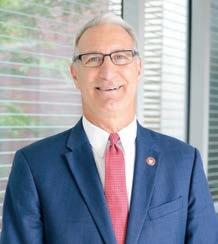
This issue’s cover features (clockwise from front) William Ciancarelli, V’19, Emily Griswold, V’20, Corbin Harris, V’21, and Carolina Panisello-Manterola, V’21. They participated in a student roundtable. See page 4.
Vice Dean, Institutional Advancement
Meaghan Hogan
Director, Communications and Marketing
Martin J. Hackett
Director of Annual Giving and Advancement Services
Mary Berger
Director of Alumni Relations
Shannon Groves
Director of Development for Companion Animals
Helen Radenkovic
Director of Development for New Bolton Center
Margaret Leardi
Associate Director, Communications for New Bolton Center
Hannah Kleckner
Web Communications Manager
Carole Cloud
Assistant Director of Institutional Events
Brittany Tinsley
Assistant Director of Annual Giving and Advancement Services
Barbara Belt
Communications Coordinator
John Donges
Advancement Services Coordinator
Sarah Trout
Administrative Assistant
Lizbeth Velez
Editor Martin J. Hackett
Contributing Editor
Sacha Adorno
Contributors
Sacha Adorno
Katherine Unger Baillie
John Donges
Hannah Kleckner
Jacob Williamson-Rea
Anne Davidson
Designer
Anne Marie Kane
Please address your correspondence to:
Martin J. Hackett
University of Pennsylvania School of Veterinary Medicine 3800 Spruce Street Philadelphia, PA 19104-6010 215-898-1475 mhackett@vet.upenn.edu

None of these articles is to be reproduced in any form without the permission of the School.
© Copyright 2019 by the Trustees of the University of Pennsylvania. The University of Pennsylvania values diversity and seeks talented students, faculty, and staff from diverse backgrounds. The University of Pennsylvania does not discriminate on the basis of race, sex, sexual orientation, gender identity, religion, color, national or ethnic origin, age, disability, or status as a Vietnam Era Veteran or disabled veteran in the administration of educational policies, programs or activities; admissions policies; scholarship and loan awards; athletic, or other University administered programs or employment. Questions or complaints regarding this policy should be directed to: Executive Director, Office of Affirmative Action and Equal Opportunity Programs, Sansom Place East, 3600 Chestnut Street, Suite 228, Philadelphia, PA 19104-6106 or by phone at 215-898-6993 (Voice) or 215-898-7803 (TDD).
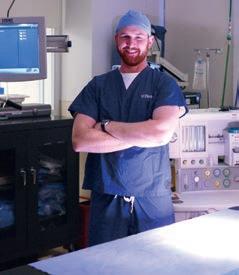 BY SACHA ADORNO
BY SACHA ADORNO
Penn Vet students think broadly about the world and how they can influence it for the better. Their talent, creativity, and desire to serve animals and people lead them into careers that expand the traditional boundaries of veterinary medicine.

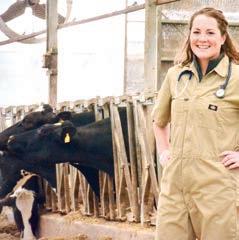
So, who are these veterinarians-tobe? We hear from four—second- to fourth-year students—who tell us their stories in their own words.
UNDERGRAD
University of Delaware
HOBBIES
Hiking, rifle and pistol marksmanship, running, and scuba diving
Second Lieutenant in the U.S. Army
EMILY GRISWOLD, V’20
UNDERGRAD
Montana State University
HOBBIES
Long distance running, skiing, hiking Helped start bovine palpation team at Penn Vet to compete in SAVMA Bovine Palpation Competition.
CORBIN HARRIS, V’21
UNDERGRAD
Emory University
MASTER OF SCIENCE
Johns Hopkins University
HOBBIES
Flying sailplanes
President of the Veterinary Business Management Association (VBMA) Club at Penn Vet
CAROLINA PANISELLOMANTEROLA, V’21
UNDERGRAD
Cornell University
HOBBIES
Cooking, hanging with her dog, Diversity Co-chair of Penn Vet SAVMA, and Co-president of Veterinarians as One Inclusive Community for Empowerment (VOICE). Involved with Admissions office and Penn’s Netter Center for Community Partnerships pipeline program.

BILL: I’ve always been drawn to service. In high school, I built a bird sanctuary at a local animal shelter for my Eagle Scout project. I also volunteered with the Guide Dog Foundation for the Blind and America’s VetDogs, where I was inspired to become a veterinarian after assisting with wellness visits.
CAROLINA: I spent summers with my grandparents in Spain. My grandmother, who knew I loved animals but wasn’t allowed a pet, always bought me a chick or little duckling. I’d raise it over the summer. At the end of the summer, it would go to live on my uncle’s farm. That time in Spain influenced me a lot.
When I was five years old, my parents suggested I could be a veterinarian and care for animals. I didn’t know what that meant, but to my five-year-old brain it sounded fantastic to work with animals for the rest of my life. Now, here I am!
CORBIN: When I was in high school, I worked after school cleaning cages and assisting technicians at a local small animal practice, even though at the time I was pre-med. The owner became a mentor to me and influenced me toward veterinary medicine.
After college, I consulted for various companies, helping human medical devices get FDA clearance. One company’s CEO was a veterinarian. He’d practiced animal medicine and was now working with animals in a different way. It was at that point I saw the applicability of veterinarians and the veterinary field. In fact, my application essay for Penn Vet was about the relevance of our education and power of the degree.
EMILY: My dad, David Griswold, V’79, is a Penn Vet alumnus and large animal veterinarian in Perry County, Pennsylvania, so I’ve always been around the profession. I was eight when I started riding horses. I wanted my own horse and joined 4H to raise goats and prove that I could care for animals. When I got the goats I was like, “Oh, goats are even better than horses.” Then, I got sheep, and I was like, “Oh, sheep are even better than goats.” I never did get a horse, but I got very involved with 4H, which tuned me into veterinary medicine.
I always liked science and animals, and got involved with FFA [Future Farmers of America] in high school. In college, I did an internship at a practice in Montana, and decided “this is it.” After graduation, I worked for that same practice for a year and did mostly cow/calf ranch work. For me, my love of veterinary medicine all centers around helping people. It’s awesome that I can help people by working with animals.
EMILY: Definitely! A lot of the difference is how my generation learns. Back then, everything was written on the chalkboard, and students had to write everything down. It seems that sort of slowed down the pace of learning a bit— and of course, the rate of disease discovery wasn’t as fast. Today, there’s so much technology that allows us to learn at our own pace. The volume of what we learn is greater and the rate we learn is quicker. The School is much more focused on getting us ready for the clinical setting and working in the world—teaching us how to communicate, and giving us more lab and hands-on time.
CAROLINA: I grew up around different cultures, and that’s been a strong factor in my identity. I really value diversity. Since undergrad, I’ve been involved with different diversity and inclusion work.
As a result, I’m very interested in community work— bringing veterinary medicine to new communities and new communities to veterinary medicine. I really love Penn Vet’s urban setting and the huge array of opportunities in a city that is very culturally, racially, and economically diverse. I will admit, I like that Philadelphia’s climate is a little warmer than Ithaca.
BILL: Although I am a New Yorker at heart, Philadelphia brings a caseload unsurpassed by other veterinary institutions. Working with various socioeconomic backgrounds enables us to learn to empathize with our clients’ constrictions but also flexibly practice medicine when necessary.
I also knew Penn Vet from college. During my junior year at the University of Delaware, I was lucky to meet with Mac Keiter, our previous Associate Dean of Admissions, who suggested I volunteered with New Bolton Center’s nursing department. Working with large animal patients and New Bolton Center students and clinicians showed me the strength of Penn Vet’s program.
CORBIN: Penn Vet was a no-brainer for me because of the resources it offers students. I knew that no matter how I applied the degree, the School’s proximity to other top-notch professional schools facilitated any interdisciplinary pursuits I may follow. Typically, many of these opportunities aren’t offered at other veterinary schools because so many are in rural locations. Throw that on top of Penn Vet’s countless examples of great clinical veterinarians, and it sealed the deal as my top choice.
EMILY: As my dad’s alma mater and the only in-state veterinary school, Penn Vet was on my radar for a long time. But I wasn’t fully aware of all the opportunities here until my interview. Penn Vet was the last school where I interviewed, so I had a feel for the other places I was considering. My interview day began with a quick tour of the Philadelphia campus followed by a full day at New Bolton Center, where we watched students participate in clinical reproduction labs and chatted with clinicians. I was blown away by nearly everything I experienced that day, from the facilities to my fellow interviewees to our student guide.
I was particularly drawn to New Bolton Center’s Marshak Dairy, swine unit, Hoffman Center for Reproduction, and the incredibly high caseload seen at the hospital and by field services.
CORBIN: When I sat down for my Penn Vet interview, I was asked what I planned to do with my degree. I was honest and said, “I genuinely have no idea. I have rough interests but I can’t tell you if I’ll do a residency, general practice, or research, because getting into Penn Vet opens many avenues.” That was my mindset walking in here. To this day, I am still excited by all the options. There are some joint degrees that I may look into—I’m considering starting a medical device company for animals, so I might be interested in getting an MBA down the road.
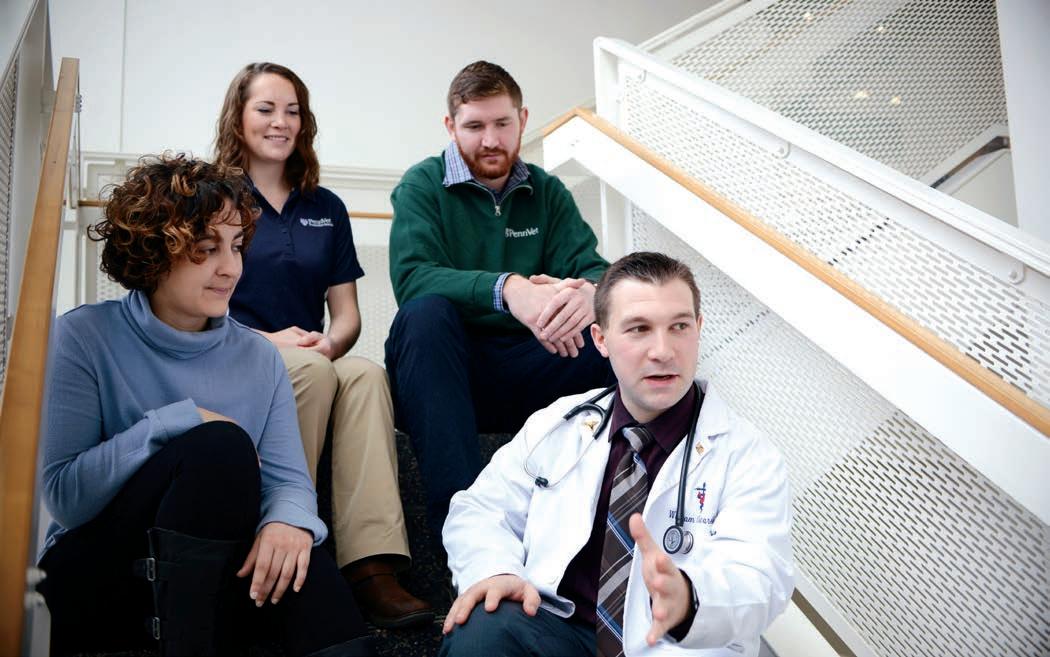
CAROLINA: Like Corbin, I don’t know exactly. I think I’m small animal, but we learn so much all the time that it opens
different directions. There are so many things we can do with this degree. So, in terms of specialty, that’s something that I’m still not sure about.
What I am very sure about is the community aspect of what we do. Like Emily, I love working with animals and people. When I started in undergrad, I thought I’d eventually go to vet school, get my degree, and open my own practice. I minored in business to prepare. Then I took an education minor, which sent me in a different direction. I began to focus a lot on social inequities and different societal issues. My business minor helped me see entrepreneurship as a way to help people and find creative solutions to issues.
EMILY: I want to go into rural practice, where I can do mostly bovine work and help farmers succeed in their businesses. Before I started vet school, I wasn’t really open to small animal medicine. Since being here, I’ve realized the communities I’d work with need care for their agricultural animals, but also for their dogs and cats and horses. I’m thinking now about going into a mixed practice setting with a focus on livestock.
BILL: I’ll be a military veterinarian for every branch of the Department of Defense (DOD), providing veterinary care to our military working dogs and pets of service members. Beginning in July of this year I will be stationed at Fort Belvoir, Virginia, where I’ll be participating in my First Year Veterinary Graduate Education (FYGVE), which is the civilian equivalent of an internship with a food mission attached. In this role, I’ll provide worldwide food safety by auditing commercial food, bottled water, and ice production facilities wanting to sell products to the DOD. I’ll ensure facilities
are selling products that are safe for our soldiers and their families. In the past, I’ve helped Veterinary Corps officers inspect Navy missile cruiser refrigerators docked in Pearl Harbor and audit an ice cream plant. When I found out that you could be a veterinarian in the U.S. Army, I knew I’d found my calling. I’m not sure if I want to be a career soldier, but I certainly want to do my part as my grandfather did in World War II. I believe serving this country is the highest of honors, and it’s a privilege to perform my duties to protect the United States as a veterinarian.
CORBIN: The School’s faculty are always available to help me figure out what I will do, and I’m enjoying the many opportunities to learn from other Penn schools. I feel like a kid in a candy store. For example, last summer I participated in the Penn Vet and Wharton Penn Executive Veterinary Leadership Program, with professors from both schools. I talked at length with my histology professor and current Ryan clinicians, and we had an exercise where we built a company. In what world would you get that experience with your professors?
BILL: Faculty and residents are very caring and concerned that we learn clinical and practical life skills. They also really push us to get out and learn in other geographies and communities. In 2016, I spent three weeks in Italy and France learning about veterinary medicine, animal welfare, and food safety public policy in Europe. I’ve also performed spay and neuter procedures for the Humane Alliance in Asheville, North Carolina, as a part of a two-week externship.
I encourage anyone with these opportunities available to them to take advantage of them to their fullest. You never know how it will benefit your development in becoming a veterinarian, both clinically and personally.
EMILY: I’ve found a niche in food animal medicine, but also can explore other interests. The School’s faculty, staff, and students are so open to ideas and able to direct us in further developing these ideas.
CAROLINA: Penn Vet really promotes entrepreneurial thinking. With the access we have to so many resources in Philadelphia and at the University, the world really is open to us.
Improving Access
“You

 BY SACHA ADORNO
BY SACHA ADORNO
On any first Saturday, the Henrietta Johnson Medical Center (HJMC) in Wilmington, Delaware, is packed with people. They might get a flu shot or blood pressure screening, but, for sure, their pets will get an exam.
Since 2017, the medical center has hosted a monthly One Health Clinic for dogs and cats.
“DHA constantly struggled with how to serve underserved communities that come to the shelter for pet care,” said Dr. Kristin Jankowski, V’94, a board member of the
Delaware Humane Association (DHA) and the clinic’s creator. “We also suspected that for every person seeking care, there are probably many others who need it but don’t ask.”
After exploring a few different approaches to meeting this need, Jankowski had the idea for a free clinic run by volunteer veterinarians and students and embedded in a communitybased human health clinic.
“We wanted to honor our strong relationships with the veterinary community and other partners,” said Patrick Carroll, DHA’s Executive Director. “The One Health
could feel how much joy and peace people felt being able to help their animals. We provided more than medical care but a chance for people to talk, be heard, and ask questions.”
Dr. Kristin Jankowski, V‘94
program was the perfect approach! We serve both people and animals, so the program is a great way to live out DHA’s mission of making friends for life.”
Jankowski dove into months of research and planning. Along with fellow DHA board members, she solicited volunteers from the University of Delaware’s undergraduate prevet program, Penn Vet’s Shelter Medicine program, and area veterinarians.
The clinic came together quickly. “We pitched it to Henrietta Johnson in August 2017 and held the first clinic in October 2017.”
Community response was powerful. “So many people came out on the first day,” said Jankowski, who is also on staff at Wilmington Animal Hospital. “You could feel how much joy and peace people felt being able to help their animals. We provided more than medical care but also a chance for people to talk, be heard, and ask questions.”
Jankowski and the team have since run 17 clinics, serving an average of 30 clients each day. Pet owners, all of whom live in two of Delaware’s lowest-income zip codes or are current patients of HJMC, rotate through four stations: check-in, clinical exam, pharmacy, and an appointment summary and review of next steps. Leashes, humane collars, and a food bank are also available onsite. All supplies, including medications, are donated or purchased with grant funds.
Penn Vet Shelter Medicine provided consulting services during the development and early execution of the clinic and is now a formal DHA partner. A Shelter Medicine intern attends the clinic, offering consistent veterinary support, and Penn Vet student volunteers staff each of the stations. Patrick Gritt, a graduate of the Penn Vet Animal Care & Control Team of Philadelphia Maddie’s® Shelter Medicine Intern, is the shelter veterinarian at DHA and supports the clinic.
While furry friends are the clinic’s primary focus, their human counterparts are just as important.
“People love their animals and often put them first,” said Jankowski. “We see when they’re empowered to care for animal loved ones, a door opens to their own health care.”
From the beginning, Jankowski’s goal for the clinic was to have pet care serve as a gateway to human health care and that veterinarians-in-training experience this interconnection while working hands-on with people and animals.

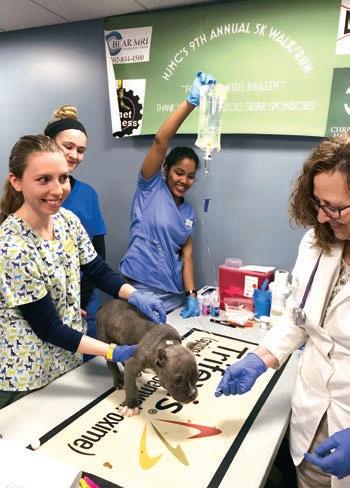
For every clinic, students read and discuss an article related to human or animal health, or the interconnection between them.
Volunteers from Wilmington University’s nurse practitioner program talk to clinic clients about health insurance and communitybased wellness resources. They offer blood pressure screenings, flu shots, and assistance in making appointments at Henrietta Johnson. And Penn Nursing is also in the process of developing a collaboration with DHA and Penn Vet to provide care at the clinic.
To better understand how the clinic is making a difference for people and animals, the Penn Vet Shelter Medicine program supported a student-driven summer research project funded through PetSmart Charities. Meriel Walsh, V’21, the student involved on the research project, is continuing her work as a member of the Rosenthal Penn Vet Shelter Medicine Student Research Fellowship program. She is collecting data on the clinic’s impact on clients, pets, and volunteers.
“My ultimate goal is for DHA One Health Delaware to become a framework for similar projects around the country and open new doors in community health,” Jankowski said. “It’s amazing to see what a group of volunteer students and professionals serving a common goal can achieve, even on a small scale.”
Of everything you’d expect to find in a bank vault, sleeping cats probably aren’t one of them. But that’s just what you’ll see in the grand old bank building on a Bridgeport, Pennsylvania, corner. The felines are patients of Bridgeport Veterinary Hospital, a small animal practice in the once-upon-a-time depository.
Dr. Craig McLahan, V’02, opened the hospital last summer, bringing to life a space that stood vacant for years. He’d been searching for a while for the right location to start a hospital. When the building went on the market, he jumped.
“This was the perfect place,” McLahan said. “I spent a lot of time getting to know the community. It’s close-knit, people really care about each other. There are a lot of pets, and owners want veterinary care they can walk to and that supports the local economy. I also learned that residents really love the old bank building—it’s a flagship for the borough. Everyone wanted to see it restored to its former magnificence.”
Bridgeport’s borough council and zoning commission weren’t going to approve just any interested buyer. According to McLahan, they’d turned down a few different proposals. Fortunately, his plan was just right for the borough’s needs.
McLahan renovated the interior of the neoclassical building, outfitting it with four exam rooms and a reception area, as well dog villas and play areas for boarding and day care. He preserved the vaults—one as a cat ward and one as the surgical suite. “They’re really quiet, which is great for cats,” he said. As the business grows, he will expand to the second floor and create additional daycare space or make it a cats-only area.

He said, “People are excited for us—people with skittish pets are really appreciative of our services.”
McLahan is referring to the hospital’s “no waiting room” policy. “Waiting rooms are terrible places for animals—and for people. They’re full of anxiety,” he said. “We don’t have one. Our receptionist takes people right back to an exam room.”
This is one of the many seemingly small, but on aggregate very impactful, details that form McLahan’s unique vision for the hospital.
“After Penn Vet, I did a lot of relief work for several practices,” he said. “I saw a lot of good in the way people did things; I also saw opportunities to make changes. Before vet school, I worked in the pharmaceutical industry, so I wanted to bring some of that corporate sensibility into my practice. In the end, I am a small business owner who is part of a community and a local economy, and I’m very mindful that my decisions affect my neighbors.”
While designing the hospital, McLahan wrote a mission statement that remains his touchstone. It promises to serve the health and welfare of animals, to respect the dignity and recognize the merit of employees, and to be good citizens.
Every decision McLahan makes, from working to reduce the practice’s carbon footprint to offering professional development for staff and discounts for seniors and veterans, considers the hospital’s immediate community and the larger world.

Not even a year into the practice, McLahan’s eye is on the horizon. “I’m excited. I have so many plans for future. I know my clients and staff are the greatest assets in making them happen.”
“In the end, I am a small business owner who is part of a community and a local economy, and I’m very mindful that my decisions affect my neighbors.”
Dr. Craig McLahan, V’02On one of the first bitter cold December mornings last fall, Dr. Joe Bender’s workday started at Summit Level farm, a nearly 100-year-old dairy owned and run by Jim and Joey Hertzler. The brothers are regular clients of Bender and the Penn Vet Center for Animal Health and Productivity (CAHP).
Located in Elverson, Pennsylvania, the farm supports three families with 100 Holsteins; it’s one of the most successful dairies of its size in Pennsylvania. But never ones to rest on success, the Hertzlers are always considering areas to refine. CAHP, which Penn Vet established in 1986 as a teaching, research, and service initiative to improve health and productivity in food animal herds and flocks, has become a regular go-to resource for them.
“We used to bring in dairy consultants. They’d get to the farm and would ask, ‘Why do you want to do better? Your cows are fine. Your business is doing well. You’re in the top 10 percent of Pennsylvania herds. Just leave it alone,’” said Joey.
The consultants’ laissez-faire attitude didn’t sit well with the Hertzlers and it doesn’t satisfy Bender, Assistant Professor of Clinical Dairy Production Medicine at New Bolton Center, whom the farmers first met nearly eight years ago. “CAHP’s philosophy is that you never stop trying to do or get better,” he said. “There is always an opportunity to improve some aspect of the dairy, either animal performance, health, or environment, or, maybe most importantly, the health of the entire farm.”
The Hertzlers’ farm, Bender said, is a model— the herd averages 105 pounds of milk per cow per day, where an average Pennsylvania herd makes 70 pounds. It’s not by accident. “Jim and Joey’s openness to troubleshooting issues and continually looking for opportunities to do better is what puts them now in the top one percent of Pennsylvania farms with fewer than 200 cows,” he said. “Every year, we bring students out here to understand successful production.”

The Hertzlers first got to know Bender while he was on staff at a private veterinary practice. In 2012 several of Summit Level’s cows were retaining placentas after giving birth, which can lead to infection and can seriously decrease milk production. Bender was their veterinarian.
“You could have taken two approaches to a situation like this,” Bender said. “One would be to put the cows on antibiotics, which is the more traditional veterinary medicine approach: The cow is broken, let’s fix it. But there are also more systematic changes we can make to preventing and solving problems. In this case, a protein deficiency was contributing to the retained placentas. We adjusted the feed and the problem went away.”
For this insight into the cows’ nutrition, Bender had consulted with Penn Vet’s Dr. Linda Baker, Associate Professor of Clinical Dairy Production Medicine. She helped analyze and adjust the cows’ diet.
“CAHP’s philosophy is that you never stop trying to do or get better. There is always an opportunity to improve some aspect of the dairy, either animal performance, health, or environment, or, maybe most importantly, the health of the entire farm.”
Joe Bender, Assistant Professor of Clinical Dairy Production Medicineat New Bolton
Center
Over time, Bender noticed more often the farms he served needed the type of expertise CAHP and the School provided more than direct clinical care for individual cows. He left private practice to join the faculty of Penn Vet in 2014.
“The questions I was starting to get from producers were beyond the scope of what I could do as a traditional veterinarian, and I wasn’t finding solutions in private practice to helping make smaller farms sustainable,” he explained.
Bender is now Baker’s colleague. The two of them work with approximately 14,000 cows across 32 clients or herds statewide. (This doesn’t include herds the pair interacts with for research projects or on their students’ dairy production medicine rotations.)
“On a normal week, I’m in the office for two days and ‘on farm’ the other three days,” Bender said. “This has been the trend for the past two years. Before that, a typical week was one or two farm visits per week and three to four days of office time. The state of the dairy industry and demand for CAHP services has resulted in my spending more time on farms.”
During his December 2018 Summit Level visit, Bender, walked the land with Joey and Jim, visiting with calves and dry and lactating cows. “I have my eyes open when on the farm—I’m looking at the hay or bedding or feed.”
Bender observed the animals, asking the brothers a question here or there. “When I’m out here, we always talk about how the cows are milking and how the brothers are doing. We’ve had a lot of rain recently. Is that affecting anything? And what can we do to keep it from impacting the animals? It’s less
about individual animals but the herd as a whole.”
In addition to observing herd health and well-being, he considers, along with the Hertzlers, where they might safely maximize profits and cut costs.
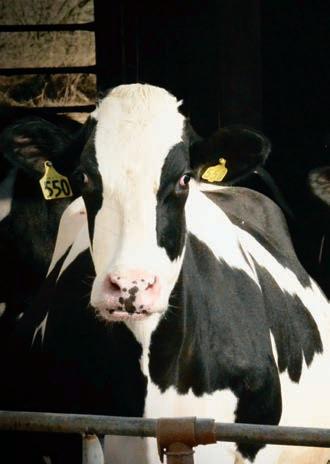
“We’re always chasing something,” said Bender. “For example, calf grain and the cost of it. If you find something you like and use it, should we go back and reevaluate it? Yes! We feed a lot of calves. If it’s $400 a ton for feed and we look at some different formulations, maybe we can do it for $375 and still keep the calves healthy. Over a year this really adds up for farmers, who have very slim margins.”
Site visits and personal client consultations are only part of Bender’s CAHP toolbox. The center also offers access, through software, to an analytical take on issues affecting producers, locally and globally.
CAHP’s Production/Reproduction Monitor imports data captured on and
from farms, which CAHP staff use to analyze and monitor herd performance. “This package is our main tool for troubleshooting production or healthrelated issues for new clients,” Bender said.
The UPenn Dairy Ration Analyzer is a subscription-based program for evaluating and formulating dairy cattle feed rations. Developed to maximize animal production and health, it also minimizes environmental impact and provides optimal cost efficiency insight to users.
A suite of online visual analytics, available to the dairy industry, can also help with decision making on farms. “This package enables comparisons of different on-farm scenarios or the use of actual farm data to make an informed economic decision, rather than leaving us to guess or ‘do what we’ve always done,’” said Bender. “It also benchmarks different parameters and shows how farms compare to other similar-sized farms.”
After visiting with the cows and reminiscing about eight years of challenges, successes, and collaboration, Jim, Joey, and Bender move inside to escape the cold and review records.
The three have an easy comradery, like friends with a shared mission. “Joe [Bender] cares about our cows. He cares about our farm,” said Jim.
It’s a process and relationship Bender appreciates. His work, he said, is as much about the people on the farm as it is with the cows. “If the farm is healthy, not just the animals, but the entire farm, then almost always the people associated with the farm will also be healthy. Ultimately the people connected to the farm are what we truly care about.”
Identifying Regional Need
“One advantage of having a mobile clinic instead of a building is that transportation is a big barrier for many communities. So, we’ll be able to go where the need is. Our animal welfare partners are confined by their brick and mortar facilities too, so we can bring services directly to them.”
Dr. Brittany Watson, Director and Clinical Assistant Professor, Shelter Medicine and Community EngagementEvery year, according to the American Society for the Prevention of Cruelty to Animals, 6.5 million stray or surrendered animals enter shelters, and 1.5 million of them are euthanized. In Philadelphia, the city’s shelter alone admitted 19,000 animals last year.
Enter Penn Vet’s Shelter Medicine program with its mission that includes keeping animals from ending up in shelters at all. The program helps improve the lives of the city’s most at-risk animals. Its new clinic on wheels will help it cover even more ground.

“We provide primary care to shelter animals, but also services to the community in collaboration with our partners,” said Dr. Brittany Watson, Director and Clinical
Assistant Professor, Shelter Medicine and Community Engagement. “Community engagement is as important as direct clinical services in preventing shelter overpopulation and increasing animal welfare. Philadelphia has areas of deep poverty and inequity. Many communities don’t have adequate health care resources for pets, and residents can’t easily travel to or afford quality care elsewhere. This can lead to surrenders or affect the humananimal bond. Then shelters and the community are overtaxed and under-resourced in their ability to help animals in need.”
The Shelter Medicine team supports shelters with critical surgical and other medical services. This includes the Penn Vet Richard Lichter Charity for Dogs Program, which provides care for dogs that are beyond the shelter’s ability to treat. The program also partners with Humane Society of the United
States’ Pets for Life program to provide at-home care in underserved neighborhoods.
“The Shelter Medicine program has been a great partner for us,” said Dr. Hillary Herendeen, Medical Director, ACCT Philly, Philadelphia’s municipal shelter and the region’s largest intake facility. “They help us on protocol development and review, give advice on disease control, and provide guidance when we adopt a new process or procedure. Having Penn Vet’s insight and partnership helps us remain at the cutting edge of sheltering and maximize lifesaving for Philadelphia’s at-risk animals.”
The program also collaborates with University programs like Netter Center for Community Partnerships. Through Netter Center programming, Shelter Medicine exposes middle and high school students to veterinary medicine, science, and the human-animal bond.
Today, Shelter Medicine and its partners are rolling out a new 40-foot-long mobile clinic to heal and help more vulnerable animals.

Outfitted for surgery and diagnostics, the traveling clinic offers services and equipment that shelters can’t afford or accommodate. In addition to exam, surgery, and recovery spaces, on board are a microscope, radiograph machine, ultrasound, and other diagnostics. Eventually, the clinic will also accommodate dental care.
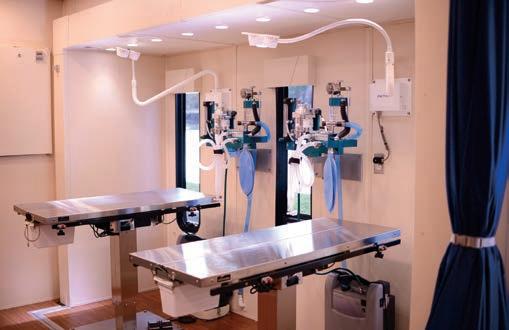
“When planning how to expand the Shelter Medicine program’s reach in the city, we looked at gaps and how to fill them,” Watson said. “One advantage of having a mobile clinic instead of a building is that transportation is a big barrier for many communities. So, we’ll be able to go where the need is. Our animal welfare partners are confined by their brick and mortar facilities too, so we can bring services directly to them.”
On a weekly basis, the clinic will operate onsite at shelters. At other times, the unit can serve as a public clinic in neighborhoods through community partnerships, as well as an opportunity for Philadelphia middle and high school students to learn about animal health and welfare. In the long term, Watson hopes to use the clinic in disaster and emergency response and animal cruelty cases.
While the concept of mobile medical services isn’t a new one, Watson pointed out that Penn Vet’s “is unique because most veterinary schools are not located in urban environments and most shelter medicine programs are embedded in a particular facility.”
She added, “We want this unit to be a robust educational tool for Penn Vet students, shelter staff, and the people of Philadelphia, one that can help us address the surgical, medical, and educational needs of the communities we serve.”
For Penn Vet students, the medical facility will be a new teaching and learning resource in a program that has grown in popularity over the past four years. Since 2014, the School’s Shelter Medicine program has seen a 55 percent increase in student enrollment, and 50 percent of Penn Vet students are registered in the program’s courses.
“Our students are deeply engaged in animal welfare, as well as human-focused issues,” said Watson. “Whether they plan to enter research, alternative careers, or private practice, early interaction with shelter medicine is important training. We want our graduates to think globally and see connections between humans, animals, and the environment. Shelter Medicine exposure helps future veterinarians understand and work within difficult and diverse contexts, which can help them serve all animals—and the world—in a more meaningful way.”
Last year, Penn Vet launched The Power of Penn Vet, a $130 million campaign falling under the University’s larger $4.1 billion The Power of Penn campaign. With four priorities, The Power of Penn Vet’s goal is to help the School maintain its position as a leader in veterinary medicine and major force in defining the field’s future:
We will empower skilled, compassionate veterinarians, ramping up access and opportunity through increased financial awards and relief for students and new and diverse dual degree programs that train a Different Kind of Veterinarian.
We will revolutionize academic programs to prepare new veterinarians for an intense pace of discovery and care. By redesigning our core curriculum, offering increased options for individualized study and expanded opportunities for the VMD-PhD program, and launching new certificate and master’s programs, we will ready our graduates for traditional and nontraditional careers.
We will upgrade our facilities for excellence. To uphold our reputation for excellent and compassionate care, we will unveil a new Emergency & Critical Care Center (ECCC) at Ryan Hospital and a new Advanced Imaging and Translational Center (AITC) at New Bolton Center. We will also offer unique occasions for skills-based learning, including a new Clinical Skills Laboratory in Philadelphia and Student Simulation and Skills Learning Center in Kennett Square.
We will enable global breakthroughs with the growing Penn Vet Cancer Center, expanded centers—like the Center for Host-Microbial Interactions and Center for Animal Health and Productivity—greater opportunities for experiential learning, and new initiatives to advance the veterinary profession worldwide.
Established four endowed professorships: Mindy Halikman Heyer President’s Distinguished Professorship, Dr. Harry Werner Professorship in Equine Medicine at New Bolton Center, Ralph L. Brinster President’s Distinguished Professorship, and the Paul A. James and Charles A. Gilmore Endowed Chair Professorship in the Department of Clinical Sciences and Advanced Medicine
Received more than $11 million in scholarship funds
Created a Student Research Fellowship in the Shelter Medicine Program
Purchased new simulation models
Completed and fully funded Phase 1 Emergency Room of the ECCC; raised $2.8 million toward the $14 million goal
Raised $2.5 million toward the $6.5 million AITC
Completed and fully funded the Shelter Medicine Mobile Unit; raised $1.5 million and achieved 100% of goal
WHERE WE ARE...Impacting the World
Penn Vet has long been a powerhouse both scientifically and clinically. But the launch of the Penn Vet Cancer Center (PVCC) last year is further bolstering those strengths in the areas of cancer research and care. A year after its launch, the PVCC is solidifying the translational science pipeline, connecting basic scientists to the clinic and vice versa, to transform veterinary cancer care.
“Our idea with the Penn Vet Cancer Center is not only to make sure that we are taking the most evidence-based, scientific approach to treating our patients who have the misfortune of receiving a cancer diagnosis,” said Dr. Ellen Puré, the center’s Director, “but that we’re also giving the most compassionate care to those pets and ensuring pet owners are educated and a key part of the decision-making process.”
By encouraging exchange and collaboration both within the multidisciplinary clinical teams that treat patients, and among them and the researchers whose scientific discoveries lead to treatment advances, PVCC aims to put a renewed focus on making breakthroughs that can save and improve the lives of animals—and the people who love them.
“The collaborations between clinicians, scientists, and clinician-scientists leverage the expertise we have in a really effective way,” said Oliver Garden, Chair of Penn Vet’s Department of Clinical Sciences and Advanced Medicine.
Since getting off the ground officially last fall, the PVCC has grown its membership, given rise to new research partnerships and projects, and rolled out new educational programming to train students and clinicians in the most up-to-date cancer biology.

When Garden was appointed to the Penn Vet faculty in 2016, in Puré’s eyes it sparked an opportunity to more closely link the research and clinical arms of the school. As a veterinarian and a scientist, with a research program that investigates the role of a type of immune cell called myeloid-derived suppressor cells in cancer and autoimmune disease, Garden welcomed the concept of the PVCC and its emphasis on integrating research and care. Garden now leads a team of faculty that share the desire to pursue better medicine both in the clinic and the lab.

Relatively recent hires include Dr. James Perry, Assistant Professor of Surgical Oncology, a PhD in immunology with an interest in how a certain type of T cells influences the trajectory of sarcomas, and Dr. Jennifer Lenz, Assistant Professor, Medical Oncology, who studies how tumors do battle with the immune system by promoting myeloidderived suppressor cells. Dr. Jennifer Mahoney, Assistant Professor, Oncology, has research interests in chemotherapy resistance and novel therapies for canine hemangiosarcoma and lymphoma, while Dr. Michael Mison, a surgical oncologist who joined Penn Vet in 2015, was promoted to Ryan Hospital Director last year, guiding hospital operations while incorporating new, less-invasive and more-tailored approaches to treating cancer surgically. They work closely with Pascale Salah, a medical oncologist at Ryan for over a decade, who evaluates and treats patients with cancer through a multidisciplinary approach.
These faculty join established Penn Vet clinicianscientists, such as Dr. Nicola Mason, Paul A. James and Charles A. Gilmore Endowed Chair Professorship within the Department of Clinical Sciences and Advanced Medicine, whose vaccine to treat osteosarcoma in dogs holds promise for translating those successes to address the same disease in children, and Dr. Susan Volk, Associate Professor, Small
Animal Surgery, whose scientific pursuits focus on the tumor microenvironment—and specifically the collagen proteins that surround tumors—and may lead to new approaches to treating breast cancer in dogs as well as people.
Puré, meanwhile, has bolstered the faculty roster in the department she chairs, Biomedical Sciences, bringing in Dr. Rumela Chakrabarti, Assistant Professor, Biomedical Sciences, whose research interrogates the factors that initiate and drive breast cancer; Dr. Andrew Vaughan, Assistant Professor, Institute for Regenerative Medicine, whose work on lung regeneration after injury has generated insights into lung cancer; and Dr. Andres Blanco, Assistant Professor, Biomedical Sciences, who examines the molecular processes by which cells form their identities and how these complex processes can go awry in cancers like acute myeloid leukemia.
In addition to a slew of recent publications pushing the cancer biology field forward, the PVCC is helping foster partnerships across departments and schools at Penn and even across the country. Mason, for example, is building on the success of her pilot study of a canine osteosarcoma vaccine, expanding the trial to 10 other institutions nationwide.

In yet another project that stands to benefit both human and animal medicine, Puré is working with Penn Medicine’s Dr. Steven Albelda, William Maul Measey Professor of Medicine, on a cancer therapy that targets the tumor microenvironment using an engineered immune cell approach. Their initial work will aim at a human therapy, with subsequent plans to adapt the approach to treat dogs.
In a separate collaboration with Penn Vet’s Dr. Serge Fuchs, Professor of Cell Biology and Director of the Mari Low Center for Comparative Oncology, and Penn Medicine’s Dr. Sandra Ryeom, Associate Professor of Cancer Biology, and Dr. Constantinos Koumenis, Richard H. Chamberlain Professor of Research Oncology, Puré is hoping to launch a project to look at what changes occur in tissues distant from
a tumor to allow cancer to “seed” and spread. That work will take advantage of a soon-to-be-established core facility that emerged out of the interests of Penn Vet Dean Andrew Hoffman, whose research into regenerative medicine has studied exosomes—tiny secreted vesicles from cells—which are also believed to play an important role in tumor metastasis.
A key component of the PVCC is education, to train the next generation of veterinarians and veterinary scientists to work toward a future where all cancers can be prevented or effectively treated. Mahoney has helped reshape an elective course for veterinary students to include clinicians. The goal of the new curriculum is to bring everyone up to speed on cancer biology and oncology, while having the side benefit of bringing different groups of people into the same room.
“It started last semester and it seems to be a big hit,” said Puré. “I like it for two reasons: First, we’re serving a wider range of stakeholders. Second, it brings students in the room with clinicians and allows them to see why it’s important to get classroom training in the science and how it’s going to impact what they do in the clinic.”
More such connections between students and working veterinary researchers and clinicians may be on the horizon, thanks to a fine-tuning of the VMD curriculum at Penn Vet being led by Dr. Jennifer Punt, Associate Dean for One Health. By condensing more classroom learning in the first three years of vet students’ education, there may be more room for students to engage in research opportunities and clinical placements that bridge their newly burnished biological knowledge to the health care needs of their future patients.
Yet another initiative to foster more training opportunities in cancer biology and medicine is a freshly launched fellowship program for scientists interested in translational research in veterinary medicine. In September, Dr. Matthew Atherton became the first Shuman Translational Research Fellow. He is a board-certified veterinary oncologist and holds a PhD in immunology. He will focus on circumventing the immune suppressive microenvironment of tumors to enable CAR T cells to function effectively in solid tumors during his time at Penn.
Though not the first veterinary cancer center in the United States, the PVCC is the only one so closely connected with a cancer center focused on human health—in this case, Penn Medicine’s Abramson Cancer Center.

“It’s so often that the veterinary clinicians are seeking help from the human clinicians, but in fact at Penn it goes both ways,” said Garden. “We absolutely have their help and expertise that we can use to the benefit of our furry friends, but our veterinary research can offer truly unique and
unparalleled opportunities for the acceleration to market of human cancer therapies in turn.”
One such research project soon to get off the ground involves the evaluation of a novel approach to radiation therapy, a common treatment for many types of cancer. Called FLASH radiation, it involves a short-duration, high-dosage exposure that preliminary studies suggest may effective kill cancer cells with less toxicity than longer exposures.
Koumenis, Professor of Radiation Oncology at Penn’s Perelman School of Medicine, who is currently spending his sabbatical at Penn Vet, will be leading the work in collaboration with Dr. Lillian Duda, Clinical Professor of Radiation Oncology at Penn Vet. The new technique may improve outcomes for pets while racking up more evidence that the approach is safe enough for wider use in humans.
“Everyone in radiation is excited to try it,” Puré said. “This is exactly the kind of innovative project that is coming to mind now that the Cancer Center has permeated people’s consciousness all around the University.”
Looking ahead, PVCC members are pursuing new relationships with biotechnology companies and researchers across Penn, and a growing engagement with the broader cancer and biomedical community, all while keeping a firm gaze on providing the best care to patients. With significant progress to date to enhance and energize what Puré called “the lab to Labrador” pipeline, the PVCC is set to be a leader in offering new and better strategies to prevent, treat, and one day eradicate the scourge of cancer.
This article is adapted, with permission, from one that appeared in Penn Today on October 9, 2018. For full article and video visit: https://penntoday.upenn.edu/news/cutting-edge-science-moves-clinichelp-our-furry-friends-fight-cancer



In February, Penn Vet completed construction on Ryan Hospital’s new emergency room. The project was generously funded by Richard Lichter, a member of Penn Vet’s Board of Overseers, and co-chair of The Power of Penn Vet Campaign. His gift was made in memory of his beloved dog, Cosette. The five-month undertaking almost triples the amount of clinical space than the former emergency room. The 2,000 square foot facility now includes designated areas for canine and feline patients. The Richard Lichter Emergency Room gives Penn Vet an opportunity to elevate animal care in a significant way. Lichter’s gift also names the future emergency room canine lobby, to be built alongside the emergency room feline lobby.
The emergency room expansion represents the first phase of a $14 million investment in our commitment to cuttingedge emergency and critical care for our patients, and their families. Future phases of the multi-phased project include enhancements to Cardiology, Radiology, as well as a state-ofthe-art Emergency and Critical Care Center.
A future surgical suite is also funded through the generosity of Helen Shinners.


In 2016, Penn Vet entered the frontlines of a revolution in imaging, becoming the first veterinary teaching hospital to install a robotics-controlled imaging system for use with standing horses. Today, this technology has evolved to become the centerpiece of New Bolton Center’s planned Advanced Imaging and Translational Center (AITC), a project supported by The Power of Penn Vet


Anchoring the AITC will be a new intra-operative, robotic computed tomography (CT) system that advances clinical diagnosis, surgical guidance, and evaluation of anatomical areas in ways never before possible. Developed specifically for New Bolton Center, the device will render extraordinarily detailed images, allowing researchers to accelerate developments and potential applications in human medicine. A state-of-the-art operating room, patient preparation area, and a new high-field MRI unit—one of the only ones of its kind on the East Coast—are also planned.
As of publication, the $6.5 million center is nearly halfway funded, with $2.5 million committed.
“Every day, working with the robots brings a new advance, a new discovery.”
Dr.Barbara Dallap Schaer, Medical Director, New Bolton Center(Top photo) architectural rendering of the AITC’s proposed surgical suite; (middle photo) robotics-controlled imaging system at New Bolton Center; (bottom photo) interior view of the proposed AITC at New Bolton Center.
As concern about climate change rises, researchers are working to develop innovative strategies to limit greenhouse gas emissions.
Methane makes up 14 percent of greenhouse gas emissions globally and is 28 times more potent than carbon dioxide at trapping heat in the atmosphere. Livestock, mostly cattle raised for dairy and beef products, produce 25 percent of methane emissions in the United States.
Dr. Dipti Pitta, Assistant Professor in Ruminant Nutrition, studies large animal nutrition and agriculture. She has received a USDA National Institute of Food and Agriculture grant of $500,000 for her research on the rumen, the large part of the cow’s first digestive chamber, or reticulorumen.
The grant funds three years of research during which Pitta hopes to better understand microbial associations in the rumen that are essential for methane mitigation. She will study how methane inhibitors function in cows that naturally produce excessive amounts of methane, as well as in cows that naturally produce lower amounts. Microbes in the rumen assist in the cows’ digestive process by breaking down plant material, but, in the process, some microbes release hydrogen as a byproduct. Methanogens, a type of microbe in the group known as archaea that are present in the rumen, consume this hydrogen to ensure that it doesn’t build up excessively in the cow’s gut. However, methanogens turn hydrogen into harmful methane, which the cows must emit.
As the global population increases, beef and dairy consumption will likely rise. But, despite advances in other aspects of agricultural efficiency, the livestock industry is struggling to keep up with methane.
“As agriculture nutrition and management has progressed, cows have been able to produce more milk and more meat while greatly reducing the methane produced.” said Pitta. “However, a single cow still produces, on average, 600 liters of methane a day.”
Pitta said researchers have tried to limit methane formation by changing cows’ diets and even using probiotics, but the success of these approaches remains unclear because of the complicated balance between methanogens and other microbes in a healthy cow.
“There can be significant negative effects when changes like these are made,” she said. “If we try to provide more methane inhibitors, it has a negative effect on the balance of archaea, which can lead to a decrease in meat or milk production, or even health issues which can have dramatic financial impact. It seems to disrupt the natural balance in the rumen, which makes it hard for the cow to eat properly.”
Pitta is collaborating with researchers at Penn State University to further understand this delicate balance. Her colleagues have worked with a synthetic compound that seems to safely reduce dairy cows’ methane emission by 30 percent while maintaining or improving milk and meat production. The compound, an enzyme analogue-containing powder, is simply added to cows’ food.
Pitta uses advanced genetic sequencing technology to analyze the microbial community in the rumen, tracking the impact on cows that have and have not consumed the compound. Results so far are promising.
“We’re seeing a continuous reduction of methane emissions in cows that consume the compound,” she said. “But with a reduction in methane, it is expected to see an increase in hydrogen production because the methanogens aren’t utilizing it, which could disrupt the natural balance in the rumen. The hydrogen levels do increase for a while, but then they come back down.”
Coupled with selective breeding methods, the synthetic feed supplement has the potential to put a huge dent in overall methane emissions. Some cows naturally emit higher levels of methane, while others emit less than average. Pitta and her colleagues have identified patterns for both high-emitting and low-emitting cows by collecting breath samples from the animals using specialized equipment and assessing them using gas chromatography, a method that allows the researchers to separate and analyze gases that cows emit.
High-emitting cows produce a different balance of methanogens and microbes that leads to more hydrogen production, and thus more methane, but, by breeding low-emitting cows and then incorporating the methane-inhibiting compound into their diet, farmers can maximize their overall efficiency while keeping methane emissions low.
“This will allow us to produce more from fewer cows,” Pitta said. “By using these methods, we could direct more energy to milk or meat production, instead of methane production. This is good for farmers and great for the environment.”
Pitta would like to eventually incorporate natural products into cows’ diets to reduce methane even further. She has a collaborator at Colorado State University who studies seaweed, and she foresees the eventual inclusion of a naturally derived seaweed compound into cows’ diets, which has the potential to knock out methanogens in the rumen.

She plans to develop advanced screening methods to better understand the rumen’s microbial and methanogen balance and then combine her findings with data from milk production and feed-consumption profiles and with findings about microbial fermentation. This could lead to an understanding of which microbes and genes could be inhibited to improve the microbial fermentation process.

By maximizing the cows’ efficiency, Pitta’s findings may not only slash methane emissions, but also help farmers decrease costs.
“It’s a win-win,” she said.
Grant number 2017-05832 is supported by funding from the U.S. Department of Agriculture National Institute of Food and Agriculture.
“We’re seeing a continuous reduction of methane emissions in cows that consume the compound. But with a reduction in methane, it is expected to see an increase in hydrogen production because the methanogens aren’t utilizing it, which could disrupt the natural balance in the rumen. The hydrogen levels do increase for a while, but then they come back down.”
Growing up in Mississippi, Dr. De’Broski Herbert, Associate Professor, Pathobiology, was warned by his great-grandmother never to walk barefoot outside. It wasn’t until a parasitology class during his sophomore year at Xavier University of Louisiana that Herbert understood the phenomenon behind his greatgrandmother’s homespun wisdom: intestinal parasites, specifically hookworms (a type of nematode). Such worms became infamous after they were discovered to cause pernicious anemia and stunted growth among schoolchildren in the southern United States at the turn of the 20th century. They were later targeted for eradication by the Rockefeller Foundation and other programs.
Hookworm larvae live in fecalcontaminated soil and can penetrate the feet of anyone who happens to walk barefoot through the area. The larvae migrate from the skin through blood vessels to the lungs; travel to the trachea, where they are swallowed; make their way to the intestine, where they mature into adult worms; and mate. The females can lay up to 30,000 eggs a day. The eggs leave the body through the feces, and the cycle continues.
It was that sophomore-year parasitology class that hooked Herbert on worms. He then spent two summers at the University of California, San Francisco (UCSF), doing undergraduate research on the blood-
infecting parasite Babesia microti (which causes malaria-like symptoms), and he became fascinated with biomedical research.
He credits his passion for science to the freedom and novelty of discovery, adopting the motto, “If the excitement of a discovery keeps you awake at night, the career possibilities are endless.”
Herbert followed his fascination for nematodes (which pose a global health problem) and immunology to David Abraham’s lab at Thomas Jefferson University in Philadelphia, where he got his PhD in immunology in 2000, and then to Frank Brombacher’s lab at the University of Cape Town, South Africa, for his postdoctoral training. He went on to hold faculty positions at the University of Cincinnati, the Cincinnati Children’s Research Foundation, and UCSF. In 2016, he became an Associate Professor of Immunology at Penn Vet.

Through the study of parasitic worms, his lab has made important contributions toward understanding the mechanisms controlling the development of alternatively activated macrophages and type 2 inflammation in the respiratory and gastrointestinal tracts.
Herbert shared his enthusiasm for nematodes with an NIH audience on June 21, 2018, when he delivered a Wednesday Afternoon Lecture (WALS) entitled “LINGO Proteins: A New Language for the Mucosal Barrier.” In that WALS talk, he told the story of how his lab used a nematode model
to discover the LINGO-2 protein (short for leucine-rich repeat and immunoglobin-like domain-containing interacting protein–2).
It turns out that a LINGO-2 deficiency in a host results in improved immunity against the nematode Nippostrongylus brasiliensis, a natural worm pathogen that infects rats.
The discovery ties into Herbert’s recent work on trefoil factors (TFFs), a family of small, abundant, secreted proteins that protect the mucous epithelia in the gastrointestinal tract. TFFs promote tissue repair, for example, in Crohn’s disease and colitis. Called trefoil factors because of their distinctive three disulfide-bridge loops,
these small signaling proteins are produced by goblet cells (secretory cells within the epithelial linings of organs mainly in the intestinal and respiratory tracts) within hours of injury and constitutively reside at epithelium locations where they can influence epithelial resistance, gastric protection, angiogenesis, and inhibit apoptosis. It was through an interest in trefoils that his lab started to study LINGO-2.
The Herbert lab found LINGO2 by using ligand-receptor capture trifunctional-chemo-proteomicsreagent (LRC-triCEPS) technology, in which bait proteins are paired with the special triCEPS compound, which consists of three domains: one to bind the ligand, one to cross-link with the target, and one to purify the captured receptor-triCEPS hybrid for mass spectrometry identification.
After a worm infection, a deficiency in LINGO-2 enhances the activation of the epidermal-growth-factor
receptor, promoting the clearing of gastrointestinal nematode infections and repair of the gastrointestinal tract. Clinical applications include the possibility of making LINGO-2 blockers to increase immunity to nematodes.
Working with nematodes has unique challenges, though. For example, the tiny worms move surprisingly quickly, making microscopy difficult, and gene deletions—the tried-and-true method for geneticists—in this particular worm species’ are not inherited in the next generation. The Herbert lab has overcome this problem recently by using worms of the asexual Strongyloides genus and by microinjection of the gonadal tissue to create a novel worm line with offspring that are genetically identical to the mutated parent. Through manipulating the genomes of both host and hookworm, the Herbert lab hopes to revitalize the field of parasite immunology.
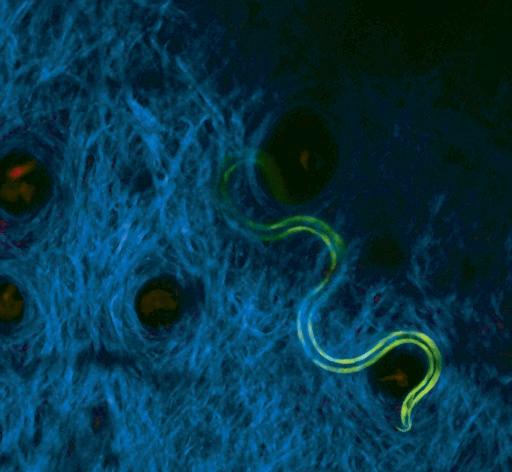
For Herbert, these challenges are part of the journey of discovery, and he makes a point of having fun with all steps along the way. For example, he names his transgenic worm lines after Marvel characters. He has a “Hulk” green fluorescent protein (GFP)labeled worm line and a “Scarlet Witch” GFP-secreting and red fluorescent protein–expressing worm line. He hopes to add more to his “marvelous” collection. Always enthusiastic about nematodes, Herbert hopes that through spreading his passion there will be “more people in the world who love worms as much as I do!”
To watch a videocast of Herbert’s WALS lecture, presented on June 21, 2018 (HHS and NIH only), visit videocast.nih.gov/launch.asp?23976.
This article is adapted, with permission, from one that appeared in the September-October issue of the NIH Catalyst. https://irp.nih.gov/catalyst/ v26i5/for-the-love-of-worms
Through the study of parasitic worms, his lab has made important contributions toward understanding the mechanisms controlling the development of alternatively activated macrophages and type 2 inflammation in the respiratory and gastrointestinal tracts.Transgenic parasitic nematode (Hulk) image in the skin of a wild-type C57BL/6 mouse. Blue is collagen, green is Hulk, and red from quantum dots.
Every year, one-third of the world’s food is wasted — this is to say, 1.3 billion tons of food produced for human consumption never reaches human mouths. When the United Nations released these figures in 2013, Dr. Zhengxia Dou, Professor of Agricultural Systems, heard a new professional calling. The longtime soil scientist refocused her research to explore complexities of food waste and sustainable solutions.

“Food waste is an economic and environmental issue. It’s also a moral issue to have so much waste polluting the environment when millions of people around the world are food insecure,” she said.
For Dou, who was raised in a small village in China, food waste is also personal. “I grew up hungry for at least the first 15 years of my life,” she said. “We worked very hard to have nutritious food, but there never was enough.”
Today, she studies how food is grown and used, and how its waste is stewarded responsibly and effectively. Her research has global implications, including in her homeland. As part of Penn Vet’s Center for Animal Health and Productivity (CAHP) and a frequent collaborator with researchers at China Agricultural University, Dou is helping to educate Chinese farmers about sustainable productivity practices.
1 CHAMPAGNE BOTTLES

I’m sentimental. My colleagues gave me champagne when I was promoted to Associate Professor and then full Professor. They are very caring and supportive. When I first came to Penn Vet I was in a strange land. I had been trained as a soil scientist, and there weren’t any soil people here. But everyone made me feel welcome. Penn is such a prestigious institution. I wasn’t sure whether I’d be able to survive and succeed here. My promotions (and the celebration of them) were a sign of peer acceptance and recognition.
2 FRONT AND BACK OF DOOR SIGNS

My daughter made both. The first is “Dou” in sign language. The second has cow spots. I love cows—they make me happy. One day she and I were driving somewhere and got lost. I was very anxious, but then we turned a bend and there were cows. I instantly felt better. So, my daughter made me the sign to hang on my door. She thought I should put it on the inside of the door where I’d see it.
3 YOGA MAT

Working on a project, whether it’s writing a grant proposal or an impactful scientific paper, gets into your head. It’s hard to turn off. Yoga helps me get out of my head. I’ll close my door and practice — I have just enough space in my office to roll out the mat.

4 BOOKS ABOUT FOOD WASTE

The year after the UN issued its Food Wastage Footprint report, Penn hosted The Last Food Mile Conference. I was Chair of the organizing committee. It was the first major multidisciplinary gathering to discuss the topic. This is the conference brochure and a book we published about the issues discussed.
5 MUGS

The mugs are from special people in my life. I came to Penn as a postdoc and the “mug-o-meter” belonged to a fellow postdoc. We shared an office. His PhD was in dairy nutrition and mine soil. We’d teach each other and had a great synergy. He left this behind when he moved on so I grabbed it. The taller one was Dr. Charlie Ramberg’s. When I got here, he was Director of CAHP and my mentor. I’d spent more than 10 years researching phosphorus. Back then, the scientific community had a misconception that phosphorus is environmentally benign, that it didn’t run from manure into water. Charlie and I would have hallway conversations. He’d ask about the chemical forms of phosphorus in manure, and I didn’t know. One day I decided to find out. At the time, there were no lab procedures to test phosphorus in manure, and my soil background came in handy. I adapted a procedure we used to characterize phosphorus in soil. The result was amazing: contrary to common belief, we found a very large proportion of the phosphorus in manure is water-soluble, which has tremendous environmental implications. These findings became very influential for farmers.
6 MOM
My mom had a big impact on my life. She was very kind and taught me the basic elements of being a good human being. My love of food and hate of waste started with her. She would try everything to feed me and my five siblings good and nutritious food. She had a dairy goat and gave the milk to me and my siblings and our grandparents. She sacrificed everything for us. Without her love and wisdom in trying to find food, particularly keeping that dairy goat and feeding us protein, I don’t know where I would be now.

7 GLOBE
A received this from a postdoc who worked here for two years with the phosphorus extraction manure samples. She is from France and sent this to me with a note that thanked me for my global view and encouraged me to always keep my interests at the global level.

To probe questions in veterinary health and disease, genomic technology has become a leading tool. But these hightech and sometimes costly approaches can prove intimidating to researchers, who may not know which technology platform best suits their purposes— and their budget—or how to extract meaningful conclusions from the massive quantities of data that result from such inquiries.

For the last five years, Penn Vet’s Center for Host-Microbial Interactions has provided researchers with a place to go to navigate these types of “omics” quandaries. Offering education, support, collaboration, and outreach, CHMI has worked to empower faculty to harness the ever-increasing power of technology to address questions that bear on both human and animal health. And looking to the future, the Center is hoping to capitalize on these advancements to revolutionize the practice of veterinary diagnostics and epidemiology.
“The technological landscape is changing quite fast,” says Dr. Christopher Hunter, Chair of the Pathobiology Department and the Mindy Halikman Heyer Distinguished Professor of Pathobiology, who envisioned the idea for CHMI after a call-out from then-Dean Joan Hendricks for “big ideas” back in 2012. He established the Center the following year in partnership with Dr. Daniel Beiting, an Assistant Professor and now the Center’s Technical Director. “The
idea was to lower the barrier for faculty at the vet school to access this type of genomic technology,” says Beiting.
Five years in, the Center has made impressive progress toward that goal.
Since 2013, CHMI has offered pilot grants to support projects that might not be ready for extramural funding, but show promise. The Center has awarded $650,000 to fund these early-stage studies, investigations that have resulted in 35 peer-reviewed publications and reaped millions in external grants.
Some CHMI-supported projects have involved productive partnerships with researchers at both Penn’s Perelman School of Medicine and Children’s Hospital of Philadelphia, through the Penn-CHOP Microbiome Program.
“In the last two years we’ve dollarfor-dollar matched the Penn-CHOP Microbiome Program to fund one joint award, that includes a PI in the vet school and a PI in the Perelman School of Medicine or CHOP who are working on a project together,” says Beiting. Other projects have emerged organically, such as an investigation of the role of the microbiome in inflammatory bowel disease involving Beiting and CHOP’s Robert Baldassano, a pediatric gastroenterologist, among others.
To bring more scientists into the fold, outreach and education have been key components of CHMI. These efforts include an annual symposium, last year’s launch of the online datamining platform MicrobiomeDB, and a
hands-on training course on the latest sequencing techniques.
Dr. Boris Striepen, a Professor of Pathobiology who recently replaced Hunter as the CHMI’s Scientific Director, says that future outbreaks are inevitable and we have to prepare today. CHMI will team up with New Bolton Center and the commonwealthwide Pennsylvania Animal Diagnostics Laboratory Service (PADLS) to make Penn Vet a leader in modern veterinary diagnostics and surveillance to protect human and animal health.
In a partnership that also includes biotechnology company Biomeme, the goal is to create cutting-edge microbial assays that make use of both targeted and high-throughput sequencing technologies to accomplish a variety of tasks, from diagnosing disease, to ensuring food safety, to monitoring antibiotic resistance organisms, to tracking productivity. By training PADLS staff on these techniques, which may even utilize hand-held devices, CHMI is accelerating progress toward safer animal agriculture and public safety.
“Genomic technologies are increasingly more portable and democratized,” says Beiting. “Sequencers are less expensive and smaller. Our researchers can be the brain trust to enable practical applications in labs or on farms, incorporating the latest and greatest approaches. That’s one of the great things about having a center like this at Penn Vet.”
Michael Atchison, PhD, was a speaker at the International Conference on Genome Architecture and Cell Fate Regulation at the University of Hyderabad, India.
Ashley Boyle, DVM, spoke at the British Equine Veterinary Association Congress in September 2018 on Combined Antigen A and C Serologic Response in Horses Vaccinated for Strangles with a Modified Live Intranasal Vaccine (Darko Stefanovski, PhD is a coauthor) and Propidium MonoazideQuantitative Realtime Polymerase Chain Reaction for the Detection of Viable Streptococcus Equi (Shelley Rankin, PhD, Kathleen O’Shea Boyajian, BS, and Darko Stefanovski, PhD, are co-authors).

Stephen Cole, VMD, is a diplomate of the American College of Veterinary Microbiology and qualified in the specialty areas of bacteriology, mycology, and immunology. He is a lecturer in microbiology, and the first Penn Vet boardcertified microbiologist and immunologist.


Raimon Duran-Struuck, DVM, PhD, has been awarded a prestigious annual prize by the Transplantation Society: the Leslie B Brent Award for the most outstanding paper published in transplantation in the field of basic science research. His paper is entitled Effect of Ex Vivo-Expanded Recipient Regulatory T Cells on Hematopoietic Chimerism and Kidney Allograft Tolerance Across MHC Barriers in Cynomolgus Macaques (2017) (Duran-Struuck R, Sondermeijer HP, Bühler L, Alonso-Guallart P, Zitsman J, Kato Y, Wu A, McMurchy AN, Woodland D, Griesemer A, Martinez M, Boskovic S, Kawai T, Cosimi AB, Wuu
CS, Slate A, Mapara M, Baker S, Tokarz R, D' Agati V, Hammer S, Pereira M, Lipkin WI, Wekerle T, Levings M, Sykes M. Transplantation.101(2): 274-283.)
Hannah Galantino-Homer, VMD, PhD, has an article in press in BMC Vet: Cassimeris L, Engiles JB, Galantino-Homer H. Detection of Endoplasmic Reticulum Stress and the Unfolded Protein Response in Obesity and Endocrinopathy-Associated Equine Laminitis. The project started as Dr. Cassimeris’s sabbatical project in the Galantino-Homer lab.
David Galligan, VMD, and Dipti Pitta, PhD, received the Penn India Research Engagement Fund Award to establish a Center of Dairy Excellence in India. Supported by training and infrastructure, the center will benefit marginal farmers by improving productivity of dairy cows.
Oliver Garden, BVetMed, PhD, attended the Provost’s Leadership Academy at the Penn Museum on September 14. His PhD student, Julia Wu, successfully completed her Viva Voce Examination in London on September 28. Her examiners were Professor Linda Woolridge and Dr. Tim Scase. She is now a postdoc in the Garden Lab. Garden presented Diagnostic Criteria for Immune-Mediated Hemolytic Anemia: Laying the Ground Rules, or Opening Pandora’s Box at the American College of Veterinary Clinical Pathologists: Current Topics in Clinical Pathology, Clinical Immunology Session on November 4 in Washington, DC. And he presented a research abstract by Dr. Jie Luo, Senior Research Investigator in Garden Lab, titled Antigen-Specific Immunotherapy of Myasthenia Gravis in Domestic Dogs: A Pilot Study at the Society of Neuroscience 48th Annual Congress in San Diego, November 3–7.

Michael Goldschmidt, BVMS, MSc, was awarded the Harold Casey Lifetime Teaching Award from the CL Davis DVM Foundation for the Advancement of Veterinary and Comparative Pathology. The award is given annually to a professor who has dedicated a career to teaching veterinary and comparative pathology. Penn Vet’s Julie Engiles, VMD, presented the award to Goldschmidt at the American College of Veterinary Pathologists 2018 annual meeting held in Washington DC.

Anna Gelzer, Dr med vet, PhD, published Yaw TJ, Kraus MS, Ginsburg A, Hadfield CA, Gelzer AR*. Comparison of a Smartphone-Based Device with a Standard Six-Lead Electrocardiogram in the Atlantic Bottlenose Dolphin (Tursiops truncatus). J Zoo Wildl Med. 2018 Sep; 49(3):689695. DOI: 10.1638/2017-0140.1. He also published Muñoz LM, Gelzer AR, Fenton FH, Qian W, Lin WY, Gilmour RF, Otani NF. Discordant Alternans as a Mechanism for Initiation of Ventricular Fibrillation In Vitro. Journal of the American Heart Association. Sep 4, 2018; 7(17): e007898. DOI: 10.1161/JAHA.117.007898.
Fuyu Guan, PhD, published Guan F, You Y, Li X, and Robinson MA. Detection and Confirmation of Alpha-cobratoxin in Equine Plasma by Solid-Phase Extraction and Liquid Chromatography Coupled to Mass Spectrometry. Journal of Chromatography A, 1533: 38-48, 2018.
Karina Guziewicz, PhD, presented Understanding the Dynamics of Subretinal Space in Health and Disease at the 2018 International Society for Eye Research in Belfast, Ireland. She contributed a book chapter: Underdeveloped RPE Apical Domain Underlies Lesion Formation in Canine Bestrophinopathies (Guziewicz KE, McTish E, Dufour VL, Zorych K, Dhingra A, Boesze-Battaglia K, Aguirre GD. Adv Exp Med Biol. 2018;1074: 309-315).
Ronald Harty, PhD, Bruce Freedman, VMD, PhD, and collaborators at Fox Chase Chemical Diversity Center were issued a patent to develop novel small molecule, broad-spectrum therapeutics against viral infections caused by hemorrhagic fever viruses including Ebola, Marburg, and Lassa fever. Currently, there are no commercially available therapeutic agents for the treatment of these viral infections. The inhibitors target a virus-host interaction necessary for efficient virus egress from
infected host cells and are thus referred to as host-oriented inhibitors. The proposed anti-viral therapeutic that targets EBOV, MARV, and LAFV is being developed for treatment of infected individuals and for prophylactic treatment of soldiers, healthcare workers, or others at high risk. Emergency administration of such an antiviral therapeutic during an outbreak would inhibit virus dissemination within infected individuals and reduce infection of newly exposed individuals, thus slowing disease progression and transmission. Drs. Harty and Freedman are the co-founders of Intervir, a start-up company whose mission is to further develop and commercialize these antiviral therapeutics.
Christopher Hunter, PhD, was the invited guru and speaker at the NIH Immunology Retreat. He was also a joint organizer and speaker at the International Cytokine and Interferon Society meeting in Boston. He also spoke at the Brazilian Protozological Society Annual Meeting in Brazil and the Yale Immunology Seminar Series. He took part in the Penn Vet Breakthrough Bike Challenge with Molly Church, VMD, PhD, and Raimon Duran-Struuck, DVM, PhD

Meryl Littman, VMD, gave six hours of continuing education lectures about Lyme and other tick-borne diseases and leptospirosis in dogs in August 2018, at the Keystone Veterinary Conference in Hershey, Pennsylvania.
Carolina López, PhD, is a visiting professor at the Institut Pasteur, Paris, sabbatical funded by a US Scholar Fulbright award from November 2018 to April 2019. She was named Associate Editor of PloS Pathogens. She published Genoyer E and López CB. Distinct Intracellular Distribution of Full-Length and Defective Viral RNA Genomes Drives Functional Heterogeneity during Infection. J. Virol. Nov 2018. DOI: 10.1128/JVI.01579-18.

David Holt, BVSc, gave the keynote speech at the 2018 Howard Hughes Medical Institute (HHMI) Medical Fellows Northeast Regional Meeting in Philadelphia.

HHMI supports scientists and educators to advance biomedical research and train the next generation of scientific leaders.
Holt is pictured with Sabina Hlavaty, V’22, co-chair of the meeting.

Wilfried Mai, Dr Méd Vét, PhD, published the book Diagnostic MRI in Dogs and Cats (CRC Press, Taylor and Francis) in September 2018. It is available at https://www.crcpress.com/DiagnosticMRI-in-Dogs-and-Cats/Mai/p/ book/9781498737708. He spoke at the Southern Europe Veterinary Conference in Madrid in October 2018 (http://sevc.info/ index.php/en/el-congreso). His remarks addressed imaging in trauma patients, CT of the acute abdomen, and the role of imaging in urinary emergencies. He also conducted a four-hour ultrasound lab.

Cynthia Otto, DVM, PhD, was a visiting professor at the Working Dog Centre of Massey University Veterinary School in Palmerston North, New Zealand, October 8–19, 2018. She was named to the National Detection Dog Breeding Co-op Working Group. She published Zanghi BM, Robbins PJ, Ramos MT, Otto CM. Working Dogs Drinking a Nutrient-Enriched Water Maintain Cooler Body Temperature and Improved Pulse Rate Recovery After Exercise. Front. Vet. Sci., 28 August 2018. DOI: 10.3389/ fvets.2018.00202. She also published Leighton EA, Hare E, Thomas S, Waggoner LP, Otto CM. Solution for the Shortage of Detection Dogs: A Detector Dog Center of Excellence and a Cooperative Breeding Program Front. Vet. Sci., 16 November 2018. DOI: 10.3389/fvets.2018.00284. She lectured at the AKC US Detection Dog Conference in Durham, North Carolina, on August 29, 2018; spoke about the efficacy of Naloxone on DHS working dogs at the Department of Homeland Security, Washington DC, on September 6, 2018; and spoke at the Working Dog Research Colloquium, Massey University, Palmerston North, New Zealand, on October 16, 2018.
Shelley Rankin, PhD, organized the 2018 PennDemic infectious disease outbreak simulation in collaboration with Deborah Becker, PhD, from Penn Nursing, and Stephen Cole, VMD, and Jennifer Punt, VMD, PhD, from Penn Vet, and former Ambassador Bonnie Jenkins of Brookings. The event was attended by students from across the campus.
Alexander Reiter, Dr med vet, Dipl. Tzt., gave lecture presentations and wet laboratories in Kyoto, Japan; Halmstad, Sweden; Phoenix, Arizona; and Vienna, Austria, between August and December 2018. He was awarded full faculty status by the Arbeitsgemeinschaft fuer Osteosynthesefragen (AO North America) and became a founding member of Oral and Maxillofacial Surgery (OMFS) of the American Veterinary Dental College (AVDC). Reiter also edited a textbook together with former Penn Vet resident and lecturer Dr. Margherita Gracis from Milan, Italy (Reiter AM, Gracis M, eds. BSAVA Manual of Canine and Feline Dentistry and Oral Surgery, 4th ed. BSAVA, Gloucester, 2018, i-vi, 1-384).
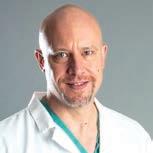
Mary Robinson, VMD, PhD, passed the board exams in June and is now a diplomat of the American College of Veterinary Clinical Pharmacology. She published five manuscripts in 2018.

Deborah Silverstein, DVM, was promoted to Professor of Critical Care in CSAM. She published Textbook of Small Animal Emergency Medicine; edited by herself, Penn Vet’s Kenneth Drobatz, DVM, and two additional colleagues outside of Penn. This is a two-volume extensive reference for all emergency veterinarians.
Charles Vite, DVM, PhD, spoke in October at the Loire Valley meeting of the International Niemann Pick Disease Foundation in France on Gene Therapy for NPC disease. He also spoke in November at the Directors Meeting of the Intellectual and Developmental Disabilities Research Centers in Boston on canine models of intellectual disability.
Susan Volk, VMD, PhD, was an invited speaker at the North American Veterinary Regenerative Medicine Conference in Sacramento in September and the American College of Veterinary Surgeons Surgery Summit in Phoenix in October, as well as the keynote speaker at Innovations in Wound Healing in Key West in December.
Youwen You, PhD, published You Y, Proctor RM, Vasilko ED, Robinson MA. Doping Control Analysis of Four JWH-250 Metabolites in Equine Urine by Liquid Chromatography–Tandem Mass Spectrometry. Drug Test Anal. 2018;1–10. DOI: 10.1002/dta.2542. He also published You Y, Guan F, D’Ippolito R, Li X, Soma LR, Robinson MA. High-Throughput Doping Control Analysis of 28 Amphetamine-Type Stimulants in Equine Plasma Using Hydrophilic Interaction Liquid Chromatography–Tandem Mass Spectrometry. Drug Test Anal. 2018;1–14. DOI: 10.1002/dta.2516.
Gustavo Aguirre, VMD, PhD, received a $427,725 grant R-01 Grant from the NIH for Models for Therapy of Hereditary Retinal Degenerations. This is the 33rd year for this grant.
Daniel Belting, PhD, received a $62,000 grant from the Pennsylvania Department of Agriculture for Development of a Rapid, Stall-Side Diagnostic Assay for Equine Respiratory Pathogens. The grant spans from January 1, 2018 to June 30, 2019.
William Beltran, DVM, PhD, received a $6,898,266 NIH U24-EY029089 grant via CHOP for Retinal Disease Models for Translational Photoreceptor Replacement. The grant spans from September 30, 2018 to August 31, 2023. He also received a $193,530 R44-EY025905 Small Business Innovation Research grant for Ambient Light Activatable Opsin-Based Therapy for Age-Related Macular Degeneration. The grant spans from June 1, 2018 to April 30, 2019.
Molly Church, VMD, PhD, received a $4,629.63 NIH Science Education Partnership Award (SEPA) with Purdue College of Veterinary Medicine for This Is How We Role: Inspiring Future Researchers through Veterinary Medicine. The grant spans from June 1, 2018 to April 30, 2019.
Raimon Duran-Struuck, DVM, PhD, received a $220,367 grant from the NIH/ NIAID Collaboration with the University of Michigan and Temple University for S-Nitrosothiol-Based Rinse/Aerosol Solutions for Treatment/Prevention of Rhinosinusitis (Phase II). The grant spans from July 2018 to July 2019. He also received a $1,633,997 grant from the Helmsley Charitable Trust for Durable Islets Transplant by Co-Administrating Engineered Regulatory T Cells. The grant spans January 2018 to December 2020.
Anna Gelzer, Dr med vet, PhD, received a $13,701 grant from CARF University of Pennsylvania for Determination of Anti-Arrhythmic Efficacy of Sotalol and Amiodarone in Boxers with ARVC by Electrophysiologic Testing, Electroanatomic Mapping, and Novel Long-Term, At-home ECG Monitoring. The grant spans from December 2018 to November 2020. Her collaborator is Cory M. Tschabrunn, PhD, CEPS, Director, Translational Electrophysiology Laboratory Cardiovascular Medicine–Cardiac Electrophysiology Program, University of Pennsylvania Perelman School of Medicine.
Mariah Gentry, DVM, received the 2019 AKC Canine Health Foundation ClinicianScientist Fellowship. She is a postdoctoral fellow, under the mentorship of Margret L. Casal, DVM, studying the heritability of renal dysplasia in cairn terriers. Her goal is to develop a DNA-based marker test, so the disorder can be diagnosed at an early age. The fellowship is generously sponsored by the Foundation of the Cairn Terrier Club of America.
Colin Harvey, BVSc, received the prestigious 2018 World Small Animal Veterinary Association (WSAVA) Award for Scientific Achievement in recognition of his work highlighting the importance of veterinary oral and dental conditions in companion animals and developing tools to incorporate dental procedures and preventive strategy into daily veterinary practice. The award, given annually to an individual who has made a significant contribution to the field of small animal medicine, was presented to him in September during the WSAVA World Congress in Singapore.


Christopher Hunter, PhD, received a $1,138,100 NIH/T32 grant for Parasitology: Modern Approaches. The grant spans September 1, 2018 to August 31, 2023. He also received a $100,000 Emerson Grant from the Abramson Cancer Center for
IL-27 in Metastatic Melanoma. The grant spans from July 1, 2018 to June 30, 2020.
Donna Kelly, DVM, received a $5,000 grant the Pennsylvania Department of Agriculture for Evaluation of Integrated Pest Management Systems in Aquaponics Production for Salmonella Species and Aeromonas Hydrophila Contamination of Harvested Product. The grant spans from January 1, 2018 to June 30, 2019.
Leszek Kubin, PhD, received a $20,000 grant from Cohen Veterans Bioscience for Model of Individual Differences in Response to Social Defeat in Rats. (The award is a subcontract from a $500,000 award to the Children’s Hospital of Philadelphia.) The grant spans from February 1, 2018 to January 31, 2020.
Carolina López, PhD, received a $470,000 per year R01AI134862-01 grant from the NIH/NIAID for Mechanism of DDO Adjuvancy. The grant spans from August 15, 2018, to July 31, 2023. She also received a $115,000 per year Collaborative Cross UNC U19 Pilot grant from NIH/NIAID for Developing an Ex-Vivo Model System of Airway Genetic Diversity. The grant spans from October 10, 2018 to August 31, 2019.
Dipti Pitta, PhD, received a one-year, $28,155 grant from the Pennsylvania Department of Agriculture for Novel Technologies for Mitigating Microbial Pollution on Livestock Farms. The goal is to investigate if novel methods such as roasting manure or composting under negative pressure are more efficient in removing antimicrobial resistant gene determinants compared to traditional manure composting or anaerobic digestion. Pitta is affiliated with the Agricultural Systems and Microbial Genomics Laboratory. Her collaborators are Zhengxia Dou, PhD, Linda Baker, VMD, Joseph Bender, DVM, and Helen Aceto, VMD, PhD

Laurel Redding, VMD, PhD, received a $16,467 grant from the Pennsylvania Department of Agriculture for Clostridium Difficile on Dairy Farms and Farm Workers The grant spans from January 2019 to January 2020. Her collaborator is Donna Kelly, DVM

Mary Robinson, VMD, PhD, received a $3,442,127 grant from the Pennsylvania Department of Agriculture State Horse Racing Commission to perform forensic drug testing on equine plasma, urine, tissue samples, and confiscated items, and to perform pharmacology research in exercised horses to support the equine anti-doping program. This marks the fortieth year of continuous funding for this program, which is directed by Robinson. The first contract was awarded to Penn Vet in 1979 to Emeritus Professor Dr. Lawrence Soma, who was asked to provide guidance regarding appropriate medication use in racehorses. The grant spans from July 1, 2019, to June 30, 2020. She is affiliated with the Penn Vet Equine Pharmacology Laboratory.
Susan Volk, VMD, PhD, received a $2,092,237 1R01GM124091 grant for The Regulatory Roles of Type III Collagen in Cutaneous Wound Healing. The grant spans from September 21, 2018 to August 31, 2023. She also received a $385,193 1R21CA-216552 grant for Type III Collagen as a Suppressor of Breast Cancer Progression and Metastasis. The grant spans from July 2018 to May 2020. She also received a $1,332,796 grant from NIH/NIGMS for The Regulatory Roles of Type III Collagen in Cutaneous Wound Healing. The grant spans from September 21, 2018 to August 31, 2023.

P. Jeremy Wang, MD, PhD, received a $4,775,101 P50 HD068157 grant from the NIH for The Penn Center for the Study of Epigenetics in Reproduction (M. Bartolomei, C. Coutifaris, and J Wang), which will elucidate epigenetic mechanisms that govern male and female reproduction, contribute to male infertility, and impact development of mouse and human concepti conceived through assisted reproductive technologies. The centerpiece of the Penn Center is three integrated, innovative research projects, spearheaded by experienced leaders in the areas of epigenetics and reproduction. The grant spans from July 23, 2018 to March 31, 2023.

Charles E. Benson, PhD, passed away in December. Benson was Professor of Microbiology and Immunology at Penn Vet and Chairman of New Bolton Center from 1989 to 1997.
Matthew Page Mackay-Smith, DVM, joined Penn Vet faculty in 1958 as its first-ever intern in equine surgery and medicine. He was an inspiring teacher who motivated students with his enthusiasm, depth of knowledge and surgical skills. He received an advanced degree in orthopedics and epidemiology from Penn and in 1962 published his thesis on the subject of Equine Osteoarthritis when it was an emerging field. In 1968, Mackay-Smith founded the Delaware Equine Center, which grew to a twelve-man practice described in the AVMA Journal as a “horseman’s practice.”
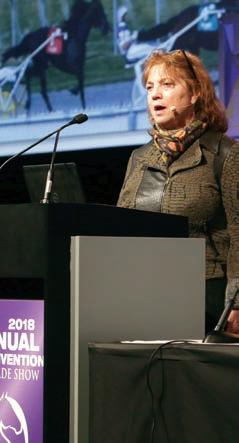

Penn Vet’s New Bolton Center had a strong presence at the American Association of Equine Practitioners (AAEP) Conference in December in San Francisco.
In addition to many staff attending the event, Dr. Virginia (Ginny) Reef, Director of Large Animal Cardiology and Diagnostic Ultrasonography, delivered the prestigious Frank J. Milne State-of-the-Art Lecture. Her talk—Straight from the Heart: Untangling the Complexities of the Equine Cardiovascular System—focused on the significance of murmurs and arrhythmias and the resulting ramifications for their treatment and management.
Also from Penn Vet, AAEP chose Dr. Regina Turner, Associate Professor, Section of Reproduction & Behavior, to represent Theriogenology during the Kester News Hour. Additionally, the Kester News Hour spotlighted six papers as the most important of the year, on two of which Dr. Amy Johnson, Assistant Professor of Large Animal Medicine and Neurology, was senior author. During the five-day conference, Dr. Nicole Scherrer, Clinical Assistant Professor, Ophthalmology, presented her work on ocular squamous cell carcinomas, and Dr. David Levine, Assistant Professor of Clinical Large Animal Surgery, participated in two Table Topics on surgical issues.
Margaret Leardi, Director of Development for New Bolton Center, and the Alumni Relations team hosted Penn Vet alumni to celebrate and network at the conference.
We cherish those who choose to give annually to Penn Vet in a generous way. Our community grows stronger each time you give, fueling The Power of Penn Vet. In honor of you, our loyal donors, we bestow this recognition based on your years of giving:
• PENNVETERINARY MEDICIN E •
1884GOLD CIRCLE
1884 GOLD CIRCLE
Our donors who’ve given for 5 or more years.
• PENNVETERINARY MEDICIN
1884SILVER CIRCLE
1884 SILVER CIRCLE
Our donors who’ve given for 3 or more years.
• PENNVETERINARY MEDICIN E • PENNVETANIMAL LOVERSSOCIETY
PENN VET ANIMAL LOVERS SOCIETY
We extend a warm welcome to our newest members who made their first gift to Penn Vet this year.
The 1884 Circle of Friends recognition connects our most loyal and steadfast donors with Penn Vet’s enduring service, since 1884, to the community and the world.
Please contact Barbara Belt (610) 925-6500
beltb@vet.upenn.edu

Established in 1982, Penn Vet’s Pet Memorial Program helps practitioners show compassion for their clients who have recently lost a beloved pet, while providing an important contribution to Ryan Hospital. The program provides financial support for the treatment and care of Penn Vet’s animal patients.
• $150 for a pack of 12 cards
• 10% discount on your order of 3 packs or more
• $15 per card if we mail the cards for you
• 50% discount on your order of 10 packs or more, plus the option of sending a monthly recurring gift for payment
For more information and an order form, visit www.vet.upenn.edu/pet-memorial-program or call 215-898-1480.

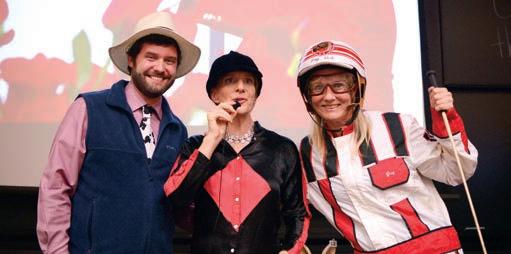
Miriam Fink, V’21, reported that Penn Vet’s One Health Club hosted a One Health in Action Symposium from October 29-November 3, 2018. It kicked off with an Anatomy Exchange and offered various lectures throughout the week. Gilad Evrony, MD, PhD, of New York University and Susan Bartlett, DVM, of the Bronx Zoo discussed the history of the divergence of human and veterinary medicine, while emphasizing that cross-disciplinary action is necessary to better the health of humans, animals, and the planet. Penn Vet’s James “Sparky” Lok, PhD, discussed zoonotic parasites, Jennifer Punt, VMD, PhD, led a case study on virus in Australia, and Nicola Mason, PhD, BVetMed, spoke with her MD counterpart Kristy Weber, MD, from Penn Medicine’s Abramson Cancer Center, about their groundbreaking osteosarcoma vaccine. Kristin Jankowski, V’94, VMD, spoke about the DHA One Health Clinic, and Jan Lovy, PhD, from New Jersey Fish and Wildlife talked about emerging diseases in local fish populations. The event brought together students from Penn Vet, Penn Medicine, Penn Dental, Penn Nursing, and the Penn Masters of Public Health Program, fostering interdisciplinary relationships to help unite the group on the One Health mission.
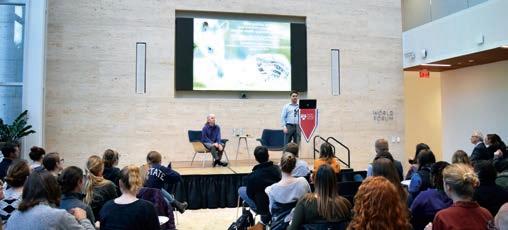
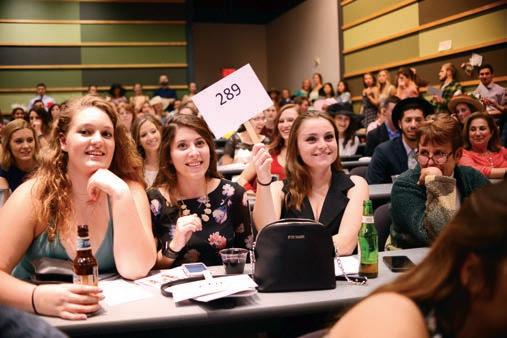
The Student American Veterinary Medical Association (SAVMA) held their annual auction to raise money for the organization. The Kentucky Derby was celebrated with this year’s theme of “Off to the Races.” Students, faculty, staff, donors, alumni, and parents donated a variety of items for the silent and live auctions. Proceeds from the auction allow SAVMA members to attend conferences and symposia throughout the year.
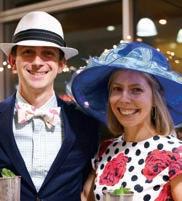


Sabina Hlavaty, V’22, a current Howard Hughes Medical Institute (HHMI)/Burroughs Wellcome Fund Research Fellow, gave a short talk on canine myeloid-derived suppressor cells at the Animals in Translation Symposium, hosted by the Institute for Regenerative Medicine in October 2018. She is affiliated with Dr. Oliver Garden. In addition, she co-chaired the 2018 HHMI Medical Fellows Northeast Regional Meeting.
Angie Smith, V’19, was awarded the Kindred Biosciences Student Scholarship to attend the American Association of Feline Practitioners Conference in Charlotte, North Carolina, in September 2018.
Catherine Thurston, V’19, was one of five students to receive a Merck Animal Health/American Association of Equine Practitioners (AAEP) Foundation scholarship at AAEP’s 65th Annual Convention. The scholarship is awarded annually to students for academic excellence, leadership in school and AAEP student chapter, and long-term goals.
Correction: An article on page 24 of the Fall 2018 issue of Bellwether incorrectly referred to Alycia Frampton’s award title. The correct title is “Selective Intestinal Cobalamin Malabsorption in Komondor Dogs: Clinical to Molecular Genetic Characterization and Ancestry Traced to Hungary.” Her study was accepted as an original paper in BMC Veterinary Research.
Achild with a swollen armpit and high fever dies in Washington, D.C. The cause is Yersinia pestis, the bacteria that causes plague. Two days later, a 35-year-old in Philadelphia is confirmed to have the plague. If you’re a public-health professional, what questions do you have? What do you need to know to protect your community?
This fictional scenario, presented in October to 85 students from different Penn schools, constituted the launch of an infectious disease outbreak simulation dubbed PennDemic. Organized by Penn Vet, Penn Nursing, Penn Medicine, Penn Graduate School of Education and School of Social Policy & Practice, and more, the daylong event was staged to evoke the working conditions of a real crisis, complete with air raid sirens, fake news updates, and rapidly changing conditions.

“The point of this is to teach students how to work in interdisciplinary teams,” said Shelley Rankin, Professor of Microbiology at Penn Vet and one of the lead organizers of PennDemic. “Getting the ‘right answer’ is not why we’re doing this. We’re letting them get to know how disciplines outside their own view things, how to capably work together, and how to manage some of the chaos that can ensue during public-health emergencies.”
This article is adapted, with permission, from one that appeared in Penn Today on October 29, 2018. For full article: penntoday.upenn.edu/news/staging-plague
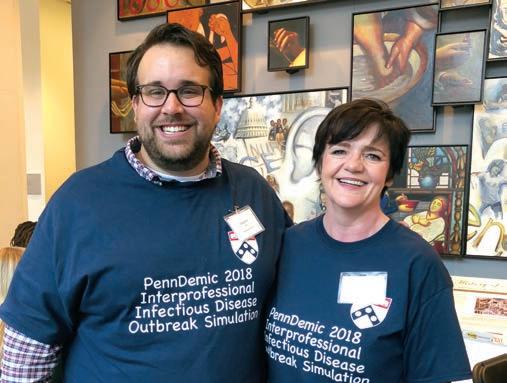

In November, science journalist Carl Zimmer kicked off the Fifth Annual Microbiome Symposium—an event co-hosted by Penn Vet’s Center for Host-Microbial Interactions and PennCHOP Microbiome Center—with a public talk about Science Reporting in the Age of Fake News. In advance of the event, he offered some thoughts and advice about the fake news phenomenon.

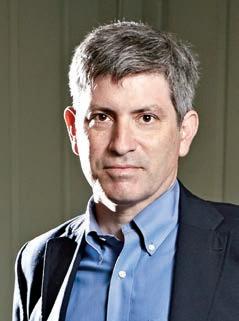
When it began: In science, the issue of fake news has been growing for a while, whether it’s websites that claim to be offering information on vaccines, trying to get people to not vaccinate, or creationist websites, or websites that distort research on climate change.
Why scientists — and everyone else — need to keep up with fake news: This issue affects everybody. It’s important for anybody reading about science in online news sources or listening to podcasts or hearing about it on the news. And it’s also important for scientists because they need to understand how their work is being perceived, how people are learning about what they do, and what are the ways that it’s being framed, or how it’s sometimes being distorted.
How we can be responsible readers: We must be more aware of the misinformation and disinformation out there. You can’t passively take in things and pass them along to friends saying, “Gosh, did you see this?” If something seems to explain the world in a convincing way that fits in with the values you already have, it’s very easy to get taken in. I think we should also hold each other to task. If a friend is sharing fake news about science, we need to say, “You should stop doing that, and here’s why it’s wrong.”
This article is adapted, with permission, from one that appeared in Penn Today on November 2, 2018. For full article visit: penntoday.upenn.edu/news/getting-science-right-fake-news-era
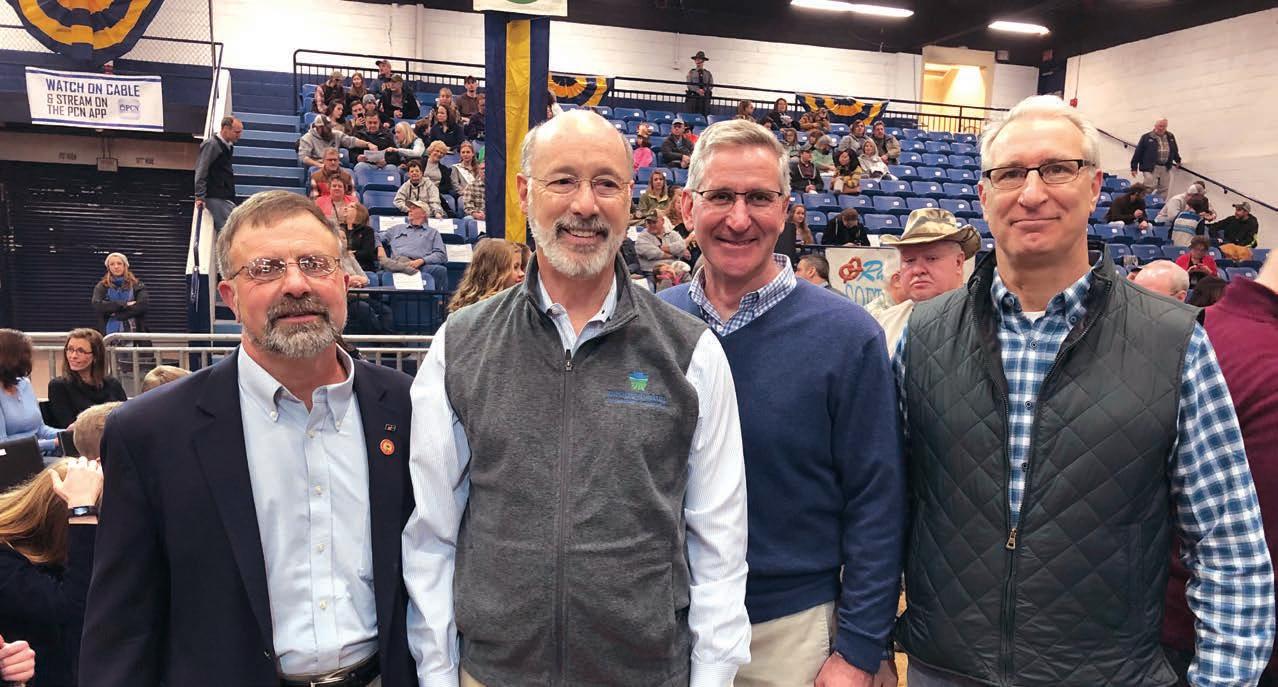 BY SACHA ADORNO
BY SACHA ADORNO
Agriculture is a $135.7 billion industry in Pennsylvania, one that supports 580,000 jobs. Penn Vet is proud of the role the School and its alumni have in the health, vitality, and sustainability of Pennsylvania’s agriculture, food systems, and wildlife. As Pennsylvania’s only veterinary school, our partnership with the state is essential to human, animal, and environmental health.
At the 2019 Pennsylvania Farm Show in January, thousands of visitors stopped by the Penn Vet booth to learn about everything the School offers the state—from disease surveillance to diagnostics, field service to hospital care, and so much more. Also on site to tell the Penn Vet story throughout the week was Dean Andrew Hoffman, who greeted curious booth visitors and walked the show.




In November, the Class of 2020 received their white coats, marking the end of their lecture years and beginning of clinical rotations. This was Dean Hoffman’s first White Coat ceremony to address (at left). Dr. Lindsay Shrieber, V’91 (at right) gave remarks and led the pinning on behalf of the Dean’s Alumni Council.


Parents and partners of the Class of 2022 visited Penn Vet for a day to learn about student life from administration, faculty, and upperclassmen. They toured both the Philadelphia and New Bolton Center campuses.




In observance of Martin Luther King, Jr. Day of Service, Penn Vet’s Ryan Hospital held a free, student-run wellness and vaccination clinic for the local community. In addition to vaccinations, low-cost, permanent identification microchips for pets were offered.







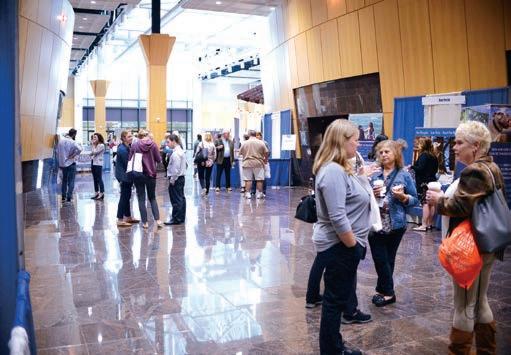
Penn Vet hosted the 118th Penn Annual Conference at the Chase Center in Wilmington, Delaware, one of the largest gatherings of veterinary colleagues, alumni, and friends in the region. Dr. Gerald O’Malley (middle bottom) delivered the Wednesday evening keynote presentation on the opioid epidemic and its effects on the veterinary community.



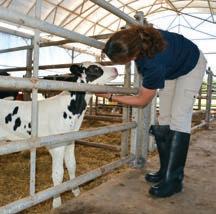

Penn Vet has named Meaghan Hogan Vice Dean of Institutional Advancement. In this role, Hogan will be responsible for the overall conceptualization, planning and execution of a coordinated program of private source fund raising, constituent relations, and communications to support the long and short range goals of the School. She will lead The Power of Penn Vet Campaign to completion.
Hogan previously served as Associate Vice President of Development at Temple University in Philadelphia. In that role she tripled principal gifts, more than quadrupled annual fundraising for the College of Liberal Arts, and played a key role in securing Temple University’s first Keck Foundation grant.
Hogan’s hire marks her return to the University of Pennsylvania. While at Penn, she served as Director of Gift
Planning, and Director of Special Projects where she managed a west coast portfolio of major gift prospects. Outside of higher education, Hogan led the Philanthropic Planning Practice at PNC Financial Services Group, Inc., where she assisted private wealth clients in their philanthropic decisionmaking process.

“I’m delighted to support Penn Vet and fulfill its aspirations for The Power of Penn Vet Campaign and beyond,” Hogan said. “The School’s mission to advance health and science for the betterment of animals, humans and the environment is more relevant and urgent than ever. We have a wonderful story to tell.”
Hogan earned her Bachelor of Arts degree in English from Vassar College; her Juris Doctor from Emory University; and her Master of Laws in Taxation from Temple University.
David Moyer, V’68, celebrated the 50th anniversary of the founding of his practice, Moyer Animal Hospital, located in Exeter Township, Pennsylvania. In a Reading Eagle profile, he shared the key to his success: “If you love what you do, it isn’t a job.” Moyer was among the first to work with fractional separation of RNA and DNA while at Penn Vet and did research on hyperthyroidism in A/D interaction with the thyroid gland.
Christopher S. Donnor, V’69, is the Founder and Past President of The Sampson Fund for Veterinary Care, a community supported fund to help financially in-need companion animals and strays receive critical care. Founded in 1986, the fund assists approximately 100 animals each year. To learn more, visit https://sampsonfund.org/.
Marc A. Rosenberg, V’71, presented a lecture at the 2018 Penn Annual Conference entitled Ethical Dilemmas: The Good, the Bad, and the Ugly. Rosenberg is the director of the Voorhees Veterinary Center and a recipient of Penn Vet’s alumni award of merit for outstanding contributions to veterinary medicine. He is a member of the American Society of Veterinary Journalists and the author of the popular DVM360 magazine column The Dilemma In 1982, he hosted the first nationally televised pet information show in the US, People, Pets, and Dr. Marc. Rosenberg was a member of the New Jersey State Board of Veterinary Medical Examiners for 12 years.
Hilton J. Klein, V’80, MS, Diplomate ACLAM, ECLAM, received the Charles A. Griffin Award at the 2018 National Meeting of the American Association for Laboratory Animal Science (AALAS) in Baltimore. The award recognizes an individual or group who has demonstrated ethical scientific and/ or technological advancements in humane experimentation or improved animal care practices. The award further recognizes contributions to the body of knowledge that advances the 3R’s: replacement,
refinement, and reduction of animals used in biomedical research. First presented in 1956, the Griffin Award is the oldest honor presented by the AALAS.
Robert J. Weiner, V’80, DABVP (Canine/ Feline) will be president of the New York State Veterinary Medical Society (NYSVMS) in 2019. The mission of the NYSVMS is to lead New York State veterinarians in education, advancement, and protection of animal well-being, public health, and the practice of veterinary medicine. Weiner is the hospital director at County Animal Hospital in New City, New York, where he has worked since 1981.
Jeffery T. Berk, V’81, a central Kentuckybased thoroughbred practitioner exclusively focused on domestic and international sales work, was installed as president of the American Association of Equine Practitioners in December at the President’s Luncheon at the AAEP’s 64th Annual Convention in San Francisco, California.
John Dascanio, V’88, received the 2018 Theriogenologist of the Year Award in August at the annual meeting of the American College of Theriogenologists. Dascanio worked his way up through the ranks as Assistant Professor and Associate Professor of Production Management Medicine at the Virginia-Maryland Regional College of Veterinary Medicine, and then as director of the Large Animal Research Park and Professor of Theriogenology at Ross University School of Veterinary Medicine. He joined Lincoln Memorial University’s College of Veterinary Medicine (LMUCVM) as a Professor of Theriogenology and director of large animal clinical skills in August 2014. In July 2016, he was appointed executive associate dean of LMU-CVM.
David Chico, V’93, of Albany, New York, was named the 2018 American Hero Veterinarian by American Humane. Chico created a free quarterly pet wellness clinic in partnership with Albany Damien Center’s PAWS (Pets Are Wonderful Support), offering veterinary care to low-income, HIV-positive pet owners. He also volunteers with Animals Lebanon in Beirut, providing lifesaving care to severely abused and neglected animals.
Marian Boden, V’96, has agreed to become the new supervising veterinarian at the Hamilton Township (New Jersey) Animal Shelter. In this role, she will provide guidance on shelter policies, procedures, animal care, and treatment, and will conduct monthly site inspections. In addition to practicing at Columbus Central Veterinary Hospital, Boden has worked at area low-cost spay and neuter clinics at the Burlington County Animal Shelter, and overseas as part of the World Vets organization.
Craig McLahan, V’02, launched Bridgeport Veterinary Hospital and Bridgeport Pet Resort & Spa in an iconic, 90-year-old bank building at Fourth Street and DeKalb Pike in Bridgeport, Pennsylvania, in July. (See page 10.)
Edward Aller, V’12, opened Art City Vets in Philadelphia. Aller previously worked at Mount Laurel Animal Hospital in New Jersey. In addition to serving regular patrons, Art City Vets plans to support local rescues and nonprofit organizations, and looks forward to helping the community in other ways.
In October, Grace Nebzydoski, V’17, married Joseph Mastroianni, V’18, with several Penn Vet alumni and friends in attendance, including: Henry Nebzydoski, V’72, Thomas Nebzydoski, V’10, Sarah Vassallo, V’15, Beth Spinelli, V’02, Patrick Kelly, V’10, Joseph Nebzydoski, V’82, Martha Franklin, V’98, John Lee DVM, Patricia Morgan, V’85, Jane Fassinger, V’90, Eric Wallis (VMRCVM ’20), Lenna Alvarez (VMRCVM ’20), Megan McClosky,

DVM DACVIM, Megan McClosky DVM DACVIM, Kat VanBeschoten, V’18, Heather Dein, DVM, Megan Ruller, V’18, Mark Peterson DVM DACVIM, Nicole Bacarella, V’18, Will Smallridge, V’18, Sindu Manoharan, V’18, Andrew Nebzydoski, V’84
Maurice J. Smith, V’48, passed away peacefully in October 2018. He practiced veterinary medicine in Mercer County for more than 60 years and owned Quaker Bridge Animal Hospital in Hamilton, New Jersey. He received the Hamilton Township Lifetime Achievement Award in 2011. Smith attended Saint Joseph’s College (now University) and then Penn Vet. What he enjoyed most in his profession was not only attending to all the animals over the years, but also engaging with the pets’ owners.
Leroy Manlove, V’52, of Newark, Delaware, and formerly of Elkton, Maryland, passed away in September. After his graduation from high school in 1944, Manlove enlisted in the US Navy and later graduated from the University of Delaware. After graduating from Penn Vet, he set up his veterinary practice in Elkton. Upon retirement from veterinary medicine, he spent two years as a flight attendant on a private jet, which allowed him to visit many cities in Europe and Asia.
Wilmington, Delaware. There he established Circle Veterinary Clinic, which is today owned by his son David Wilkins, V’86
Jack William Zimmerly, V’60, died in April. After graduating from Philadelphia’s Northeast High School in 1948, he enlisted in the US Navy and served on the USS Midway as an electrician’s mate. His first dream was to own a dairy, which he realized he could not afford. Instead he earned his degree in veterinary medicine from Penn Vet and practiced until 2002. He practiced small animal medicine at the Glenwood Pet Hospital in Erie, Pennsylvania, and served as exotics vet to the Erie Zoo. For many years, he provided services to the Humane Society of Erie. Zimmerly was passionate about preserving quality of life for animals and often repeated his oath to prevent suffering.
John W. Kenline, V’61, of Canon City, Colorado, passed away in June. He owned Kenline Veterinary Clinic from 1967 to 1998 and practiced mixed animal veterinary medicine. He was dedicated, compassionate, and much loved by his clients, so much so that 20 years after he sold his practice, the clinic still bears his name.
Alan Bachrach, V’68, passed away in September. After finishing an internship at Henry Berg Memorial Hospital in Manhattan, he completed a fellowship at Angell Memorial Hospital (now Medical Center) in Boston and did his residency in ophthalmology at the Ohio State University. Bachrach founded his specialty practice in ophthalmology just outside Boston. In addition, he was involved with many research projects, instituted clinical ophthalmology rounds at MSPCA-Angell, and established the ophthalmology department at the Tufts University School of Veterinary Medicine.
John Sainsbury, V’68, passed away in August.
John Langley Wilkins, V’52, passed away in November. Wilkins served in the Marine Corps in World War II. After graduating from Penn Vet, he practiced primarily in

Deborah Lochner, V’71, of Spencer, Tennessee, passed away in September, at age 72. She worked for several years as a practicing small animal veterinarian before starting a family. She was involved with the Unites States Pony Clubs and was
the founder of both the Sundance Pony Club in Stillwater, Oklahoma, and the Mossy Creek Pony Club in Fort Valley, Georgia. She worked toward a master’s degree in technical writing at Oklahoma State University and later taught biology at Georgia Military College in Warner Robins, Georgia.
Ronald Landy, V’82, passed away in October 2018. In keeping with his lifetime interest in supporting the health of wildlife and ecosystems, Landy had a rewarding career in public health and environmental protection, including 34 years with the US Public Health Service, the Environmental Protection Agency, and other government entities. He and his wife, Paula, his partner in these adventures, established the Ronald B. Landy V’82 Family Travel Scholarship to encourage future veterinarians to seek out innovative and cutting-edge career paths by exploring novel areas of veterinary medicine. For more information, visit www.vet.upenn. edu/ronald-landy-scholarship.
Penn Vet graduates achieve remarkable successes every day. Whether you have a new address, are moving forward in your career, announcing an addition to the family, or honoring the life of a fellow alumnus, Alumni Relations wants to hear about it. Please share your news! Visit the Alumni page of the Penn Vet website, email your news to the alumni office at grovessh@vet.upenn.edu, or write to us at Alumni Relations, Penn Vet Alumni Office, 3800 Spruce Street, Suite 172E, Philadelphia, PA 19104. We may edit submissions due to space considerations.
Penn Vet is pleased to appoint four new members to its Board of Overseers, an advisory body to the Dean. Overseers are professionals, experts, and informed lay people who provide volunteer leadership and serve as ambassadors and spokespersons for Penn Vet by linking the School to the world.
Joining the Board are Kathryn Lloyd Champ, who serves as the Executive Director of the Bernice Barbour Foundation, a family foundation founded by Champ’s father. Raised in New Jersey on a farm with horses and dogs, Champ worked in design for Calvin Klein and Geoffrey Beene after graduating from Georgetown University. Champ is a member of Animal Grantmakers and the Pasadena Art Alliance. She lives in California with her family.
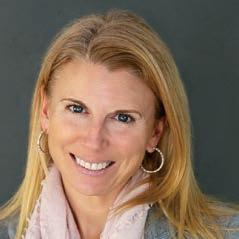
Marc A. Hembrough, founding partner of Wharton Business Group, LLC, and a 1984 graduate of the University of Pennsylvania’s Wharton School, offers more than three decades of experience working with high net-worth individuals and institutions on areas such as business succession/leadership planning, incentive compensation, and tax and estate planning.
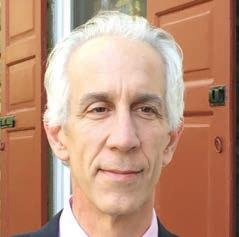

Hembrough resides in Pennsylvania, where he and his wife Katie are longtime supporters of Main Line Animal Rescue and the PSPCA. He supports numerous charities, is on the Board of Camp Cadet (State Police), Co-Chair of the Marine Corp Scholarship Foundation’s Philadelphia Ball Committee, and supporter of Penn athletics.
Also from Pennsylvania, Keith Morgan, a University of Pennsylvania alumnus, brings more than 35 years of leadership experience in many aspects of management, business development, brand awareness, customer service, operational excellence, and marketing. Morgan spent most of his career as CEO (1992-2006) of AAMCO Transmissions. Most recently, he launched two Pennsylvania-based companies, Holistic Farms and Holistic Pharma, both of which were awarded medical marijuana permits pursuant to the Pennsylvania Medical Marijuana Program.
Morgan has served on the boards of many nonprofits, including The Free Library of Philadelphia, The Shipley School, Suzanne Morgan Foundation, Cancer Support Community, and Penn Medicine.

Philanthropist, entrepreneur, and conservationist Christa B. Schmidt is a longtime supporter of Penn Vet. For 12 years, Schmidt was on the Board of Directors for Mars Incorporated, including as Chairman. She holds extensive nonprofit governance experience, having been a long-standing member of the Philadelphia Zoo Board of Trustees, Pennsylvania Ballet, and Opera Philadelphia. Schmidt has also been an active supporter of the Thorncroft Equestrian Center, Gesu School, Children’s Hospital of Philadelphia, Nemours Alfred I. duPont Hospital for Children, Greener Partners, and the Horizons Program.
Schmidt, who graduated from Duke University, and her family enjoy life on their organic farm in Pennsylvania, which provides an array of produce and a home for many large and small animals.
Penn Vet mourns the passing of Robert P. Levy, C’52, Emeritus Trustee of Penn and a member of the School’s Board of Overseers from 1992 to 1998 (Emeritus from 1997 to 2018).
Levy was born in Philadelphia and went to William Penn Charter School before attending the University of Pennsylvania and obtaining a degree in sociology. He was chair of DRT Industries, a Philadelphia-based conglomerate with industrial holdings in the Delaware Valley.
Levy joined the University’s Board of Trustees in 1971 and became a member of the Student Life Committee. He also brought great insight to his role on Penn Vet’s Board of Overseers, where he helped advance sports medicine for racehorses, such as his own 1987 Belmont Stakes winner, Bet Twice. He was also a longtime member of the Athletics Overseer Board and volunteered as an assistant coach for the women’s tennis team. He also served as chair of the Board of Overseers for the School of Dental Medicine. In 2003, Levy received the Alumni Award of Merit.

Levy and his family made possible the Robert P. Levy Tennis Pavilion, the Dental School’s Levy Research Building (now the Levy Center for Oral Health Research), the Paley Professorship for the Dean of the School of Design, and Blanche P. Levy Park in the center of campus.
Read more about Levy’s may illustrious accomplishments in his full obituary at almanac.upenn.edu/articles/robert-levyemeritus-trustee.
3800 Spruce Street
Philadelphia, PA 19104-6008
United Way of Greater Phila. & So. NJ: #50178
APRIL 2
First Tuesday Lecture Series
A free educational lecture series for horse owners and horse enthusiasts
So You’ve Always Wanted to be a Vet: A Day in the Life of a Vet Student at New Bolton Center
6:30–7:30 PM
New Bolton Center Alumni Hall
Kennett Square, PA
MAY 7
First Tuesday Lecture Series
A free educational lecture series for horse owners and horse enthusiasts
Unraveling Laminitis: What We Know and Where We’re Going
6:30–7:30 PM
New Bolton Center Alumni Hall
Kennett Square, PA
MAY 17–18
Alumni Weekend & Reunion
Philadelphia & Kennett Square
MAY 20
Commencement
Penn Vet
Philadelphia, PA
JUNE 4
First Tuesday Lecture Series
A free educational lecture series for horse owners and horse enthusiasts
Paleolithic to Picasso: Interesting Stuff About Horse Anatomy
6:30–7:30 PM
New Bolton Center Alumni Hall
Kennett Square, PA
JUNE 12
Animal Lovers Lecture Series
A free series for all animal lovers.
Understanding Your Pet’s Emotions to Enhance Quality of Life
6:30–7:30 PM
New Bolton Center
Alumni Hall
Kennett Square, PA
AUGUST 2
American Veterinary Medicine Association Alumni Reception
Washington, DC
AUGUST 16
Pennsylvania Veterinary Medical Association
Alumni Reception
Hershey Lodge
Hershey, PA
SEPTEMBER 25–26
Penn Annual Conference
Chase Center on the Riverfront, Wilmington, DE